Formal Operational Stage – Piaget’s 4th Stage (Examples)

Would you say that you think abstractly? Do you think about the “bigger picture?” I don’t mean thinking about your life 10 years in the future. I mean thinking about the purpose of existence and why humans have evolved as we have. We’re not tackling all of these questions today, but we will talk about how we came to ask them and how we answer them.
Children in elementary or middle school typically do not possess these skills. Until children reach the formal operational stage in Jean Piaget's Theory of Cognitive Development, they go through three concrete development stages that only allow them to think concretely. They can follow the rules of how the world works but are limited by these concrete concepts.

What Is the Formal Operational Stage?
Once children reach adolescence, they enter the Formal Operational Stage. This is the last stage in Piaget’s Theory of Cognitive Development. The Formal Operational Stage doesn’t end - there are ways that you can heighten your abstract problem-solving skills from age 12 to age 112!
The formal operational stage begins between around 11-12. Children are usually in grade school around this time. They can take on more responsibilities than they did in earlier stages of development, but they are still considered young children. Health organizations still categorize ages 11 and 12 as "middle childhood."
Entering the Formal Operational Stage
Children ages 11 and 12 have just finished the concrete operational stage. This stage lasts from ages 6-11. By the time a child enters the formal operational stage, they should be able to:
- Arrange items in a logical order
- Build friendships based on empathy
- Understand that 5mL of water in one glass is the same amount as 5mL of water in a separate glass
- Recognize that a ball of pizza dough is the same as flattened pizza dough
Playing games and doing science experiments with children is much more fun at this age. They understand so much more!
During this stage, individuals develop the ability to think abstractly, reason logically, and solve problems in a systematic manner. Here are 14 examples of behaviors and thought processes that are characteristic of the formal operational stage:
- Hypothetical Thinking : The ability to consider hypothetical situations and possibilities. For instance, a teenager might ponder, "What would happen if the sun never rose?"
- Abstract Thought : Thinking about concepts not directly tied to concrete experiences, such as justice, love, or morality.
- Systematic Problem Solving : When faced with a problem, individuals can systematically test potential solutions. For example, if a science experiment doesn't produce the expected result, a student might change one variable at a time to determine which one is responsible.
- Metacognition : The ability to think about one's own thought processes. Students might reflect on how they study best or recognize when they do not understand a concept.
- Moral Reasoning : Moving beyond black-and-white thinking to consider the nuances of moral dilemmas. For instance, understanding that stealing is generally wrong but pondering whether it's justified if someone is stealing food to feed their starving family.
- Scientific Reasoning : Formulating hypotheses and conducting experiments in a methodical manner to test them.
- Understanding Sarcasm and Metaphors : Recognizing that the phrase "It's raining cats and dogs" doesn't mean animals are falling from the sky.
- Planning for the Future : Considering future possibilities and making plans based on them, such as choosing college courses based on a desired future career.
- Evaluating the Quality of Information : Recognizing the difference between opinion and fact or understanding that just because something is on the internet doesn't make it true.
- Logical Thought : Thinking logically and methodically, even about abstract concepts. For example, if all roses are flowers and some flowers fade quickly, then some roses fade quickly.
- Considering Multiple Perspectives : Understanding that others might have a different point of view and trying to see things from their perspective.
- Propositional Thought : Understanding that a statement can be logical based solely on the information provided, even if it's untrue. For instance, "If all dogs can fly and Fido is a dog, then Fido can fly" is logically sound, even though we know dogs can't fly.
- Complex Classification : Classifying objects based on multiple characteristics. For example, organizing books by both genre and author.
- Understanding Abstract Relationships : Recognizing relationships like "If A is greater than B, and B is greater than C, then A is greater than C."
What Characterizes the Formal Operational Stage?
Four specific skills are signs that a child is in the formal operational stage:
Deductive Reasoning
Abstract thought, problem-solving.
- Metacognition
The child learns to apply logic to certain situations during the Concrete Operational Stage . But they are limited to inductive reasoning. In the Formal Operational Stage, they start to learn (and learn the limits of) deductive reasoning.
Inductive reasoning uses observations to make a conclusion. Say a student has six teachers throughout their life, all strict. They are likely to conclude that all teachers are strict. They may find that later in life, they will change their conclusion, but until they observe a teacher who is not strict, this is the conclusion they will come to.
Deductive reasoning works differently. It uses facts and lessons to create a conclusion. The child will be presented with two facts:
“All teachers are strict.”
“Mr. Johnson is a teacher.”
Using deductive reasoning, the child can conclude that Mr. Johnson is strict.
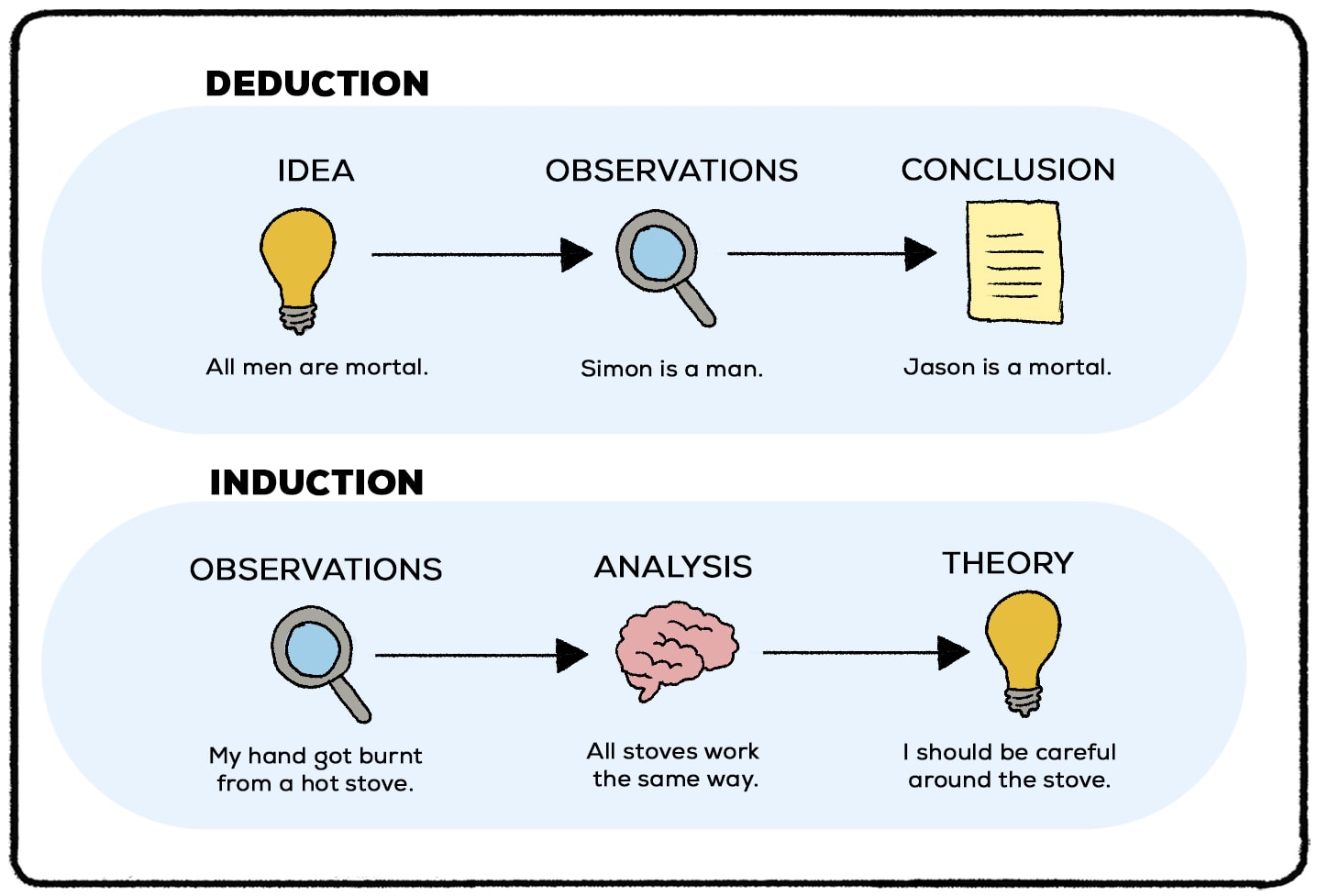
Throughout the child’s development, they start to expand their world. In the sensorimotor stage, their world consists of only what is directly in front of them. If something is out of sight or earshot, it no longer exists.
As they develop object permanence, they understand that the world exists beyond what they can physically see, hear, or touch. In the concrete operational stage, children begin to apply the rules of logic to things and rules they know exist.
In this final stage, they begin to expand their worldview further. They begin to develop abstract thought. They can apply logic to situations that don’t follow the rules of the physical world.
Piaget's Third Eye Question: The Difference Between Concrete Operational and Formal Operational Stages
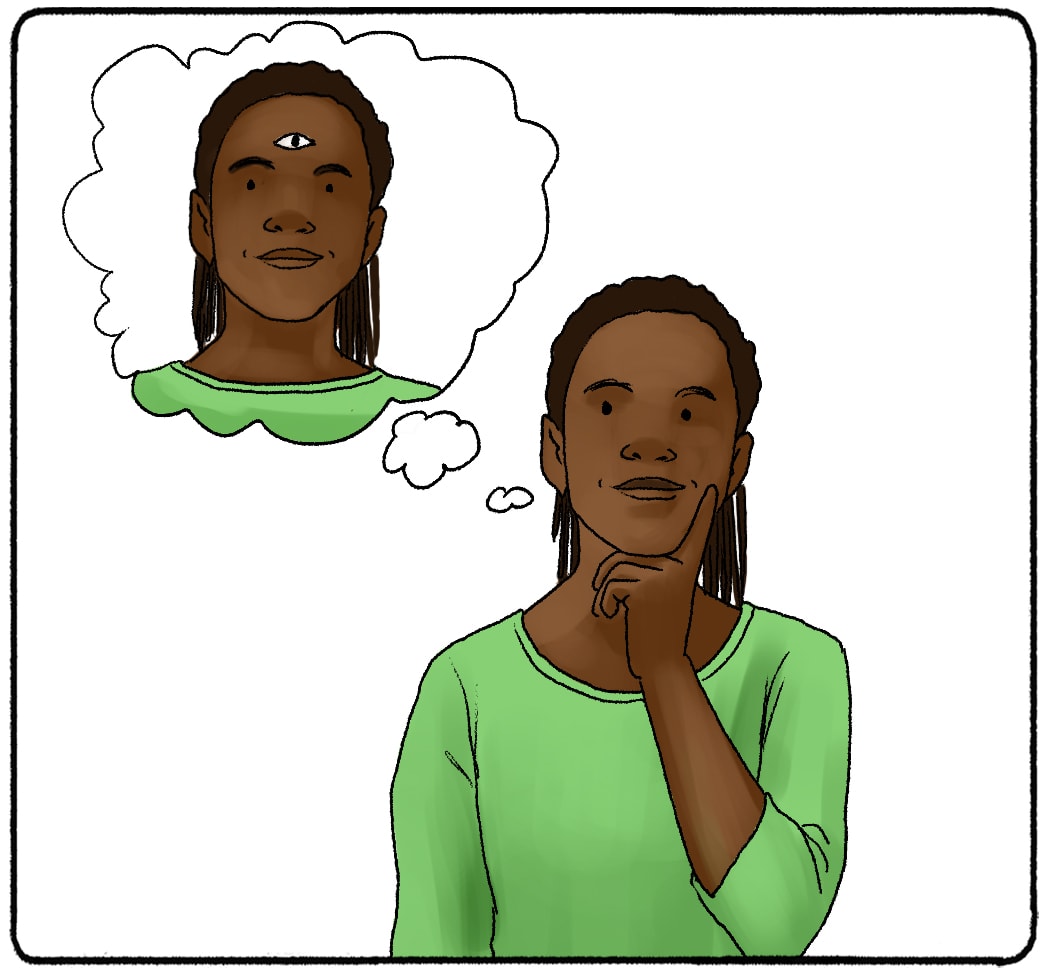
One of the ways that Piaget tested this skill was to ask the children questions. Here’s an example of a question that Piaget asked children:
“If you had a third eye, where would you put it?”
Children in the Concrete Operational Stage were limited to answering that they would put the eye on their forehead or face. They were typically only exposed to animals and humans with eyes on their faces. But children in the Formal Operational Stage were likelier to branch out and think of more useful and abstract answers. They considered putting the eye on their hand, back, or elsewhere where it would serve a greater purpose.
These skills make solving problems a whole lot easier. Children can only solve problems through trial and error in the Concrete Operational Stage and earlier stages. As they enter the Formal Operational Stage, they can look back at the problem, use past experience and reasoning to form a hypothesis, and test out what they believe will happen. This can save them a lot of time.
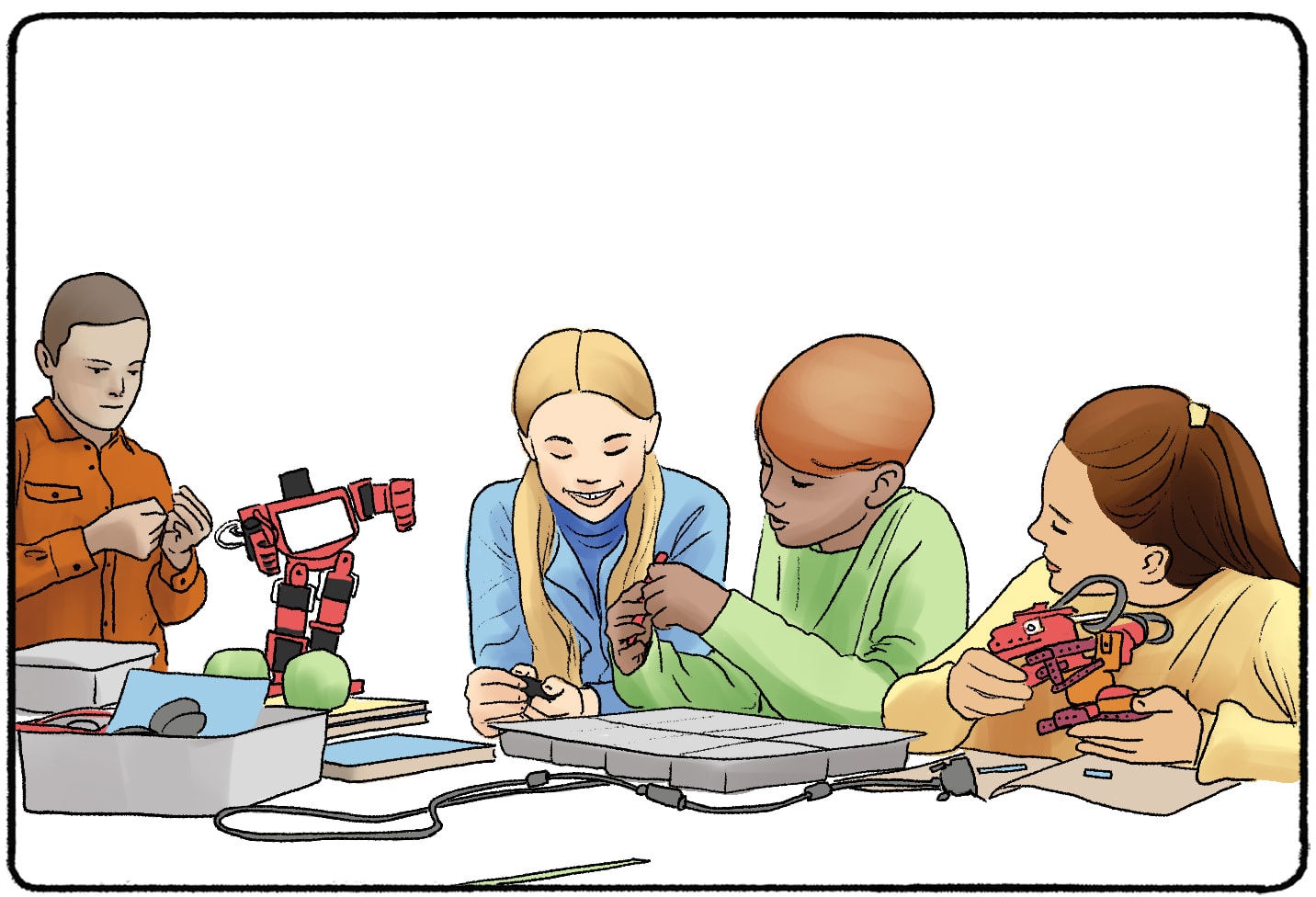
To determine when children had developed these skills, Piaget used another testing method. He gave them a scale with a set of weights and asked them to balance the scale with the weights. But simply putting the same amount of weight on each side wasn’t enough. The children had to determine that the distance between the weights and the scale's center also impacted the balance.
Children under the age of 10 heavily struggled with the task because they could not understand the concept of balance (if they were in the Preoperational Stage) or could not grasp that the center of balance is also important. (These children were in the early stages of the Concrete Operational Stage.) At age 10, the children could solve the problem, but at a much slower pace due to their process of trial and error.
It wasn’t until age 11 or 12 that children could look at the problem from a distance and use logic to use both the distance and size of the weights to balance the scale.
MetaCognition
Not all of these thought processes are perfect the first time around. You know that I know that, and children in the Formal Operational Stage are just starting to discover that. By using MetaCognition, they are more likely to assess their thinking and transform it into a more effective form of problem-solving.
MetaCognition is simply “thinking about thinking.” It is the ability to run through your own thought process, figure out how you developed that process, and maybe unwind some things that aren’t logical or can be disproven. This can help you “rebuild” your thought process as if it were building blocks, creating a more solid structure for you to solve problems.
Piaget did not actually coin this term while developing his theory on the Formal Operational Stage. John Flavell, an American psychologist, actually proposed the theory on MetaCognition in the late 1970s.
We’ve seen throughout these videos that the Theory of Cognitive Development has continued to grow and change with additional input and studies. Our minds can also change their thought processes and begin to notice imperfections and flawed logic as they come up. But this often requires going back and asking yourself how you built certain thought processes and where you could have made flawed conclusions.
How to Support a Child in the Formal Operational Stage
Children in the formal operational stage (typically 12 years and older) begin thinking more abstractly and logically, engaging in hypothetical reasoning and considering multiple variables in problem-solving. To best support and nurture their cognitive development outside of school, consider these activity suggestions:
- Play Strategic Board Games: Introduce games that require planning, strategizing, and critical thinking. Games like chess, Risk, Settlers of Catan, and Ticket to Ride can enhance their deductive reasoning and promote patience. These games also often require players to predict opponents' moves, honing their skills in understanding perspectives.
- Engage in Thought Experiments: Stimulate abstract thinking by posing hypothetical questions. Asking imaginative yet thought-provoking questions like, "If you could invent a new school subject, what would it be and why?" or "How would our lives change if we had no electricity for a year?" can spark interesting discussions and foster creativity.
- Encourage Scientific Experiments: Let them set up a mini-lab at home. Whether it's a simple vinegar and baking soda reaction or a more complex examination of plant growth under different conditions, hands-on experiments can solidify their understanding of cause and effect.
- Delve into Philosophy and Ethics: Discuss moral dilemmas or philosophical conundrums suitable for their age. Questions like, "Is it ever okay to lie?" or "What makes something 'right' or 'wrong'?" can challenge them to consider multiple viewpoints and refine their moral reasoning.
- Read and Analyze Stories Together: Choose books or movies with deeper themes or complex characters. Discuss the motives, the plot's implications, or any symbolism. This improves their comprehension skills and teaches them to think critically about media.
- Involve Them in Real-Life Problem-Solving: Whether planning a family trip, budgeting for a big purchase, or deciding on the best route for a journey, including them in the process can provide practical applications for their developing logical reasoning skills.
- Respect and Respond to Their Queries: Children at this stage are brimming with questions, many of which can be profound or reflective. When they approach you with a query, respond with patience and logic. If you don't know the answer, consider researching it together. This collaborative approach provides them with information and models a proactive attitude toward learning.
By actively engaging with children in these ways, parents and caregivers can provide invaluable support as they navigate the challenges and opportunities of the formal operational stage.
Formal Operational Stage vs. Other Stages of Development
Jean Piaget is not the only psychologist to create stages of development. Other psychologists have offered their theories on how a child develops social skills and how their experiences during each stage impact their relationships and behavior. Some theories, like Erikson's stages of psychosocial development, last for the span of the person's life. Other theories, like Piaget's, only cover childhood and early adolescence. When we compare Piaget's theory to other theories, we see some overlap and other perspectives on what makes a child the person they grow up to be.
Erikson's Stages of Psychosocial Development
At ages 11-12, a child exits the Industry vs. Inferiority stage and enters the Identity vs. Role Confusion stage. The child should be aware that they are responsible for their own decisions and how they affect others. They also start to see that they are different from other children. They will successfully exit these stages if they feel confident that they can advocate for themselves and live the way they want. Otherwise, they may develop insecurities. Erikson coined the term "identity crisis." This crisis could take place in the identity vs. role confusion stage!
Freud's Stages of Psychosexual Development
During the ages of 11-12, a child is in the latent stage of psychosexual development and may be entering the genital stage. The change in stages all depends on when the child goes through puberty. Freud's controversial stages focused on a child's erogenous zones and sexual interests. As the child discovers sexual interests in the latent stage, they must learn to channel their energy into intellectual activities. The child can form healthy relationships by letting the superego tame the id. In the genital stage, teenagers and adults learn to explore their maturing sexual interests.
Which Theory is "Right?"
All these theories can play out simultaneously, but remember, these are just theories. Some ideas, like Freud's Oedipal Complex that occurred in earlier stages of development, have been discredited and largely rejected by today's psychologists. We continue to learn about Jean Piaget, Erik Erikson, and other psychologists to understand how psychology developed into the field we know today.
Thanks for checking out these pages on the Theory of Cognitive Development! I hope these will allow you to look at your own thinking and build a stronger foundation for solving problems and understanding the world around you - no matter how old you are!
Piaget's Influence on Modern Educational Practices
Jean Piaget's groundbreaking theories on cognitive development have left an indelible mark on the realm of education. Even today, educators worldwide employ strategies rooted in Piaget's insights. Here's how Piaget’s theories continue to shape contemporary educational practices:
- Active Learning: Piaget emphasized the importance of active learning. He believed children learn best when interacting with their environment and manipulating objects. This belief has shifted from passive rote memorization to hands-on, experiential learning. Schools often incorporate field trips, lab experiments, and interactive activities to facilitate this.
- Developmentally Appropriate Practices: Recognizing that children progress through specific stages of cognitive development, educators design curricula tailored to these stages. For instance, in the pre-operational stage (2-7 years), children benefit from using concrete objects and visuals. Meanwhile, older children in the formal operational stage (12 years and up) are more equipped for abstract thinking and can engage in more complex problem-solving tasks.
- Focus on the Process, Not Just the Outcome: Piaget believed that the process of thinking and the journey of arriving at an answer are just as necessary as the answer itself. This philosophy has encouraged educators to value and assess how students approach problems, not just the correctness of their answers.
- Peer Interaction: Piaget felt that peer interaction is crucial for cognitive development. He observed that children often learn best when discussing, debating, and collaborating with classmates. Group work, cooperative learning, and classroom discussions are now staples in many classrooms, promoting social interaction as a valuable learning tool.
- Incorporating Real-life Situations: To make learning meaningful, Piaget suggested relating it to real-life situations. This has led to problem-based learning and the inclusion of real-world issues in the curriculum, ensuring that students see the relevance and applicability of their learning.
- Role of the Teacher: In line with Piaget's theories, the teacher's role has evolved from the traditional "sage on the stage" to more of a "guide on the side." Teachers now often act as facilitators, providing resources, posing guiding questions, and helping students make their discoveries.
- Assessment Practices: Piaget's emphasis on stages of cognitive development has led to more nuanced and stage-sensitive assessment methods. Teachers are more attuned to the developmental readiness of their students, ensuring that assessments are appropriate for their cognitive level.
- Constructivist Classrooms: Stemming from Piaget's idea that learners construct knowledge based on their experiences, many modern classrooms adopt a constructivist approach. Here, students are encouraged to construct their understanding and knowledge of the world by experiencing and reflecting on those experiences.
While educational practices have evolved and integrated various theories, Piaget's influence is unmistakably prevalent. His focus on the child as an active learner, the stages of cognitive development, and the significance of hands-on, relevant learning continues to shape how education is delivered in the 21st century.
Related posts:
- Concrete Operational Stage (3rd Cognitive Development)
- Piaget's Theory of Moral Development (4 Stages + Examples)
- Jean Piaget’s Theory of Cognitive Development
- Havighurst’s Developmental Task Theory
- The Psychology of Long Distance Relationships
Reference this article:
About The Author

Developmental Psychology:
Developmental Psychology
Erikson's Psychosocial Stages
Trust vs Mistrust
Autonomy vs Shame
Initiative vs Guilt
Industry vs inferiority
Identity vs Confusion
Intimacy vs Isolation
Generativity vs Stagnation
Integrity vs Despair
Attachment Styles
Avoidant Attachment
Anxious Attachment
Secure Attachment
Lawrence Kohlberg's Stages of Moral Development
Piaget's Cognitive Development
Sensorimotor Stage
Object Permanence
Preoperational Stage
Concrete Operational Stage
Formal Operational Stage
Unconditional Positive Regard
Birth Order
Zone of Proximal Development
PracticalPie.com is a participant in the Amazon Associates Program. As an Amazon Associate we earn from qualifying purchases.
Follow Us On:
Youtube Facebook Instagram X/Twitter
Psychology Resources
Developmental
Personality
Relationships
Psychologists
Serial Killers
Psychology Tests
Personality Quiz
Memory Test
Depression test
Type A/B Personality Test
© PracticalPsychology. All rights reserved
Privacy Policy | Terms of Use
Piaget’s Theory and Stages of Cognitive Development
Saul Mcleod, PhD
Editor-in-Chief for Simply Psychology
BSc (Hons) Psychology, MRes, PhD, University of Manchester
Saul Mcleod, PhD., is a qualified psychology teacher with over 18 years of experience in further and higher education. He has been published in peer-reviewed journals, including the Journal of Clinical Psychology.
Learn about our Editorial Process
Olivia Guy-Evans, MSc
Associate Editor for Simply Psychology
BSc (Hons) Psychology, MSc Psychology of Education
Olivia Guy-Evans is a writer and associate editor for Simply Psychology. She has previously worked in healthcare and educational sectors.
On This Page:
Key Takeaways
- Jean Piaget is famous for his theories regarding changes in cognitive development that occur as we move from infancy to adulthood.
- Cognitive development results from the interplay between innate capabilities (nature) and environmental influences (nurture).
- Children progress through four distinct stages , each representing varying cognitive abilities and world comprehension: the sensorimotor stage (birth to 2 years), the preoperational stage (2 to 7 years), the concrete operational stage (7 to 11 years), and the formal operational stage (11 years and beyond).
- A child’s cognitive development is not just about acquiring knowledge, the child has to develop or construct a mental model of the world, which is referred to as a schema .
- Piaget emphasized the role of active exploration and interaction with the environment in shaping cognitive development, highlighting the importance of assimilation and accommodation in constructing mental schemas.
Stages of Development
Jean Piaget’s theory of cognitive development suggests that children move through four different stages of intellectual development which reflect the increasing sophistication of children’s thought
Each child goes through the stages in the same order (but not all at the same rate), and child development is determined by biological maturation and interaction with the environment.
At each stage of development, the child’s thinking is qualitatively different from the other stages, that is, each stage involves a different type of intelligence.
Although no stage can be missed out, there are individual differences in the rate at which children progress through stages, and some individuals may never attain the later stages.
Piaget did not claim that a particular stage was reached at a certain age – although descriptions of the stages often include an indication of the age at which the average child would reach each stage.
The Sensorimotor Stage
Ages: Birth to 2 Years
The first stage is the sensorimotor stage , during which the infant focuses on physical sensations and learning to coordinate its body.

Major Characteristics and Developmental Changes:
- The infant learns about the world through their senses and through their actions (moving around and exploring their environment).
- During the sensorimotor stage, a range of cognitive abilities develop. These include: object permanence; self-recognition (the child realizes that other people are separate from them); deferred imitation; and representational play.
- They relate to the emergence of the general symbolic function, which is the capacity to represent the world mentally
- At about 8 months, the infant will understand the permanence of objects and that they will still exist even if they can’t see them and the infant will search for them when they disappear.
During the beginning of this stage, the infant lives in the present. It does not yet have a mental picture of the world stored in its memory therefore it does not have a sense of object permanence.
If it cannot see something, then it does not exist. This is why you can hide a toy from an infant, while it watches, but it will not search for the object once it has gone out of sight.
The main achievement during this stage is object permanence – knowing that an object still exists, even if it is hidden. It requires the ability to form a mental representation (i.e., a schema) of the object.
Towards the end of this stage the general symbolic function begins to appear where children show in their play that they can use one object to stand for another. Language starts to appear because they realise that words can be used to represent objects and feelings.
The child begins to be able to store information that it knows about the world, recall it, and label it.
Individual Differences
- Cultural Practices : In some cultures, babies are carried on their mothers’ backs throughout the day. This constant physical contact and varied stimuli can influence how a child perceives their environment and their sense of object permanence.
- Gender Norms : Toys assigned to babies can differ based on gender expectations. A boy might be given more cars or action figures, while a girl might receive dolls or kitchen sets. This can influence early interactions and sensory explorations.
Learn More: The Sensorimotor Stage of Cognitive Development
The Preoperational Stage
Ages: 2 – 7 Years
Piaget’s second stage of intellectual development is the preoperational stage . It takes place between 2 and 7 years. At the beginning of this stage, the child does not use operations, so the thinking is influenced by the way things appear rather than logical reasoning.
A child cannot conserve which means that the child does not understand that quantity remains the same even if the appearance changes.
Furthermore, the child is egocentric; he assumes that other people see the world as he does. This has been shown in the three mountains study.
As the preoperational stage develops, egocentrism declines, and children begin to enjoy the participation of another child in their games, and let’s pretend play becomes more important.
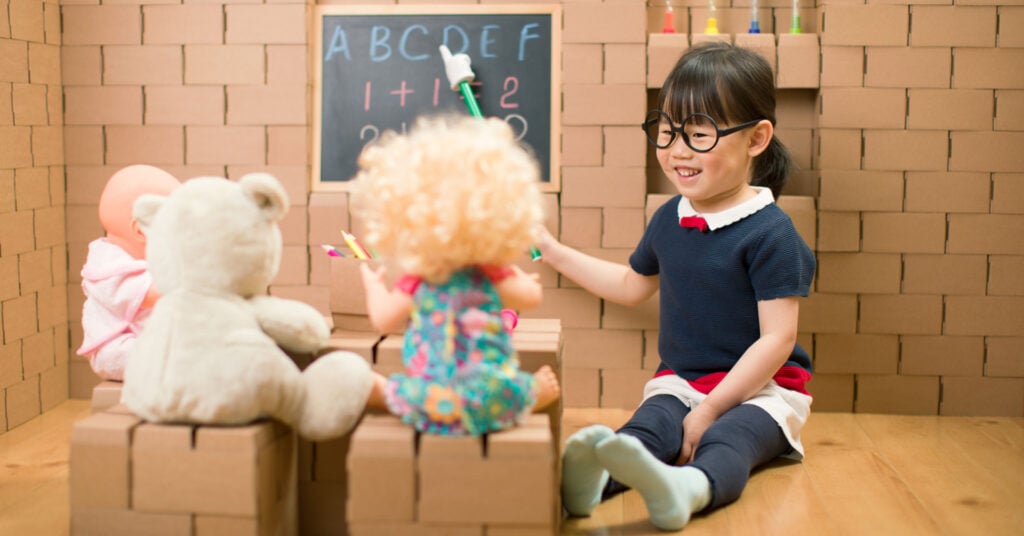
Toddlers often pretend to be people they are not (e.g. superheroes, policemen), and may play these roles with props that symbolize real-life objects. Children may also invent an imaginary playmate.
- Toddlers and young children acquire the ability to internally represent the world through language and mental imagery.
- During this stage, young children can think about things symbolically. This is the ability to make one thing, such as a word or an object, stand for something other than itself.
- A child’s thinking is dominated by how the world looks, not how the world is. It is not yet capable of logical (problem-solving) type of thought.
- Moreover, the child has difficulties with class inclusion; he can classify objects but cannot include objects in sub-sets, which involves classifying objects as belonging to two or more categories simultaneously.
- Infants at this stage also demonstrate animism. This is the tendency for the child to think that non-living objects (such as toys) have life and feelings like a person’s.
By 2 years, children have made some progress toward detaching their thoughts from the physical world. However, have not yet developed logical (or “operational”) thought characteristics of later stages.
Thinking is still intuitive (based on subjective judgments about situations) and egocentric (centered on the child’s own view of the world).
- Cultural Storytelling : Different cultures have unique stories, myths, and folklore. Children from diverse backgrounds might understand and interpret symbolic elements differently based on their cultural narratives.
- Race & Representation : A child’s racial identity can influence how they engage in pretend play. For instance, a lack of diverse representation in media and toys might lead children of color to recreate scenarios that don’t reflect their experiences or background.
Learn More: The Preoperational Stage of Cognitive Development
The Concrete Operational Stage
Ages: 7 – 11 Years
By the beginning of the concrete operational stage , the child can use operations (a set of logical rules) so they can conserve quantities, realize that people see the world in a different way (decentring), and demonstrate improvement in inclusion tasks. Children still have difficulties with abstract thinking.

- During this stage, children begin to think logically about concrete events.
- Children begin to understand the concept of conservation; understanding that, although things may change in appearance, certain properties remain the same.
- During this stage, children can mentally reverse things (e.g., picture a ball of plasticine returning to its original shape).
- During this stage, children also become less egocentric and begin to think about how other people might think and feel.
The stage is called concrete because children can think logically much more successfully if they can manipulate real (concrete) materials or pictures of them.
Piaget considered the concrete stage a major turning point in the child’s cognitive development because it marks the beginning of logical or operational thought. This means the child can work things out internally in their head (rather than physically try things out in the real world).
Children can conserve number (age 6), mass (age 7), and weight (age 9). Conservation is the understanding that something stays the same in quantity even though its appearance changes.
But operational thought is only effective here if the child is asked to reason about materials that are physically present. Children at this stage will tend to make mistakes or be overwhelmed when asked to reason about abstract or hypothetical problems.
- Cultural Context in Conservation Tasks : In a society where resources are scarce, children might demonstrate conservation skills earlier due to the cultural emphasis on preserving and reusing materials.
- Gender & Learning : Stereotypes about gender abilities, like “boys are better at math,” can influence how children approach logical problems or classify objects based on perceived gender norms.
Learn More: The Concrete Operational Stage of Development
The Formal Operational Stage
Ages: 12 and Over
The formal operational period begins at about age 11. As adolescents enter this stage, they gain the ability to think in an abstract manner, the ability to combine and classify items in a more sophisticated way, and the capacity for higher-order reasoning.
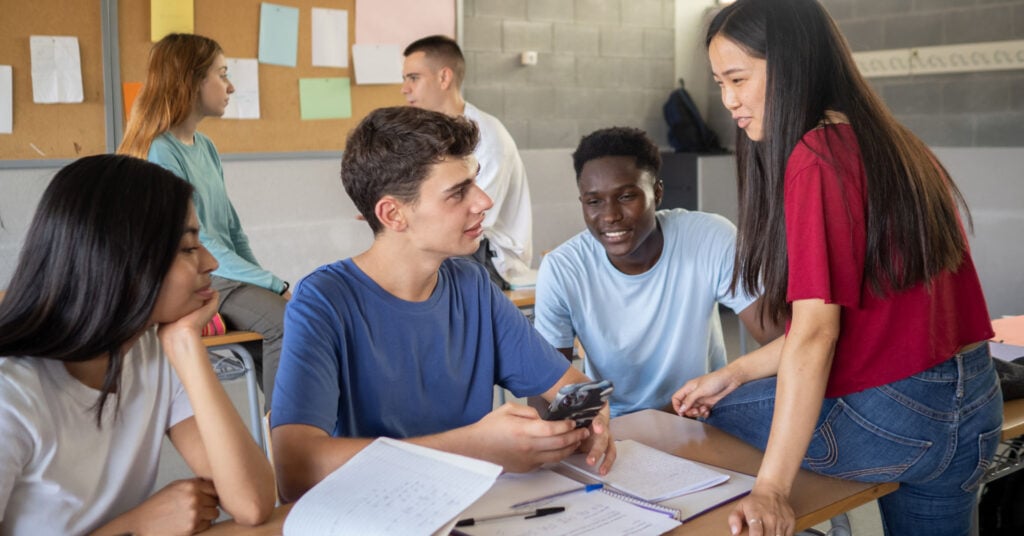
Adolescents can think systematically and reason about what might be as well as what is (not everyone achieves this stage). This allows them to understand politics, ethics, and science fiction, as well as to engage in scientific reasoning.
Adolescents can deal with abstract ideas: e.g. they can understand division and fractions without having to actually divide things up, and solve hypothetical (imaginary) problems.
- Concrete operations are carried out on things whereas formal operations are carried out on ideas. Formal operational thought is entirely freed from physical and perceptual constraints.
- During this stage, adolescents can deal with abstract ideas (e.g. no longer needing to think about slicing up cakes or sharing sweets to understand division and fractions).
- They can follow the form of an argument without having to think in terms of specific examples.
- Adolescents can deal with hypothetical problems with many possible solutions. E.g. if asked ‘What would happen if money were abolished in one hour’s time? they could speculate about many possible consequences.
From about 12 years children can follow the form of a logical argument without reference to its content. During this time, people develop the ability to think about abstract concepts, and logically test hypotheses.
This stage sees the emergence of scientific thinking, formulating abstract theories and hypotheses when faced with a problem.
- Culture & Abstract Thinking : Cultures emphasize different kinds of logical or abstract thinking. For example, in societies with a strong oral tradition, the ability to hold complex narratives might develop prominently.
- Gender & Ethics : Discussions about morality and ethics can be influenced by gender norms. For instance, in some cultures, girls might be encouraged to prioritize community harmony, while boys might be encouraged to prioritize individual rights.
Learn More: The Formal Operational Stage of Development
Piaget’s Theory
- Piaget’s theory places a strong emphasis on the active role that children play in their own cognitive development.
- According to Piaget, children are not passive recipients of information; instead, they actively explore and interact with their surroundings.
- This active engagement with the environment is crucial because it allows them to gradually build their understanding of the world.
1. How Piaget Developed the Theory
Piaget was employed at the Binet Institute in the 1920s, where his job was to develop French versions of questions on English intelligence tests. He became intrigued with the reasons children gave for their wrong answers to the questions that required logical thinking.
He believed that these incorrect answers revealed important differences between the thinking of adults and children.
Piaget branched out on his own with a new set of assumptions about children’s intelligence:
- Children’s intelligence differs from an adult’s in quality rather than in quantity. This means that children reason (think) differently from adults and see the world in different ways.
- Children actively build up their knowledge about the world . They are not passive creatures waiting for someone to fill their heads with knowledge.
- The best way to understand children’s reasoning is to see things from their point of view.
Piaget did not want to measure how well children could count, spell or solve problems as a way of grading their I.Q. What he was more interested in was the way in which fundamental concepts like the very idea of number , time, quantity, causality , justice , and so on emerged.
Piaget studied children from infancy to adolescence using naturalistic observation of his own three babies and sometimes controlled observation too. From these, he wrote diary descriptions charting their development.
He also used clinical interviews and observations of older children who were able to understand questions and hold conversations.
2. Piaget’s Theory Differs From Others In Several Ways:
Piaget’s (1936, 1950) theory of cognitive development explains how a child constructs a mental model of the world. He disagreed with the idea that intelligence was a fixed trait, and regarded cognitive development as a process that occurs due to biological maturation and interaction with the environment.
Children’s ability to understand, think about, and solve problems in the world develops in a stop-start, discontinuous manner (rather than gradual changes over time).
- It is concerned with children, rather than all learners.
- It focuses on development, rather than learning per se, so it does not address learning of information or specific behaviors.
- It proposes discrete stages of development, marked by qualitative differences, rather than a gradual increase in number and complexity of behaviors, concepts, ideas, etc.
The goal of the theory is to explain the mechanisms and processes by which the infant, and then the child, develops into an individual who can reason and think using hypotheses.
To Piaget, cognitive development was a progressive reorganization of mental processes as a result of biological maturation and environmental experience.
Children construct an understanding of the world around them, then experience discrepancies between what they already know and what they discover in their environment.
Piaget claimed that knowledge cannot simply emerge from sensory experience; some initial structure is necessary to make sense of the world.
According to Piaget, children are born with a very basic mental structure (genetically inherited and evolved) on which all subsequent learning and knowledge are based.
Schemas are the basic building blocks of such cognitive models, and enable us to form a mental representation of the world.
Piaget (1952, p. 7) defined a schema as: “a cohesive, repeatable action sequence possessing component actions that are tightly interconnected and governed by a core meaning.”
In more simple terms, Piaget called the schema the basic building block of intelligent behavior – a way of organizing knowledge. Indeed, it is useful to think of schemas as “units” of knowledge, each relating to one aspect of the world, including objects, actions, and abstract (i.e., theoretical) concepts.
Wadsworth (2004) suggests that schemata (the plural of schema) be thought of as “index cards” filed in the brain, each one telling an individual how to react to incoming stimuli or information.
When Piaget talked about the development of a person’s mental processes, he was referring to increases in the number and complexity of the schemata that a person had learned.
When a child’s existing schemas are capable of explaining what it can perceive around it, it is said to be in a state of equilibrium, i.e., a state of cognitive (i.e., mental) balance.
Operations are more sophisticated mental structures which allow us to combine schemas in a logical (reasonable) way.
As children grow they can carry out more complex operations and begin to imagine hypothetical (imaginary) situations.
Apart from the schemas we are born with schemas and operations are learned through interaction with other people and the environment.
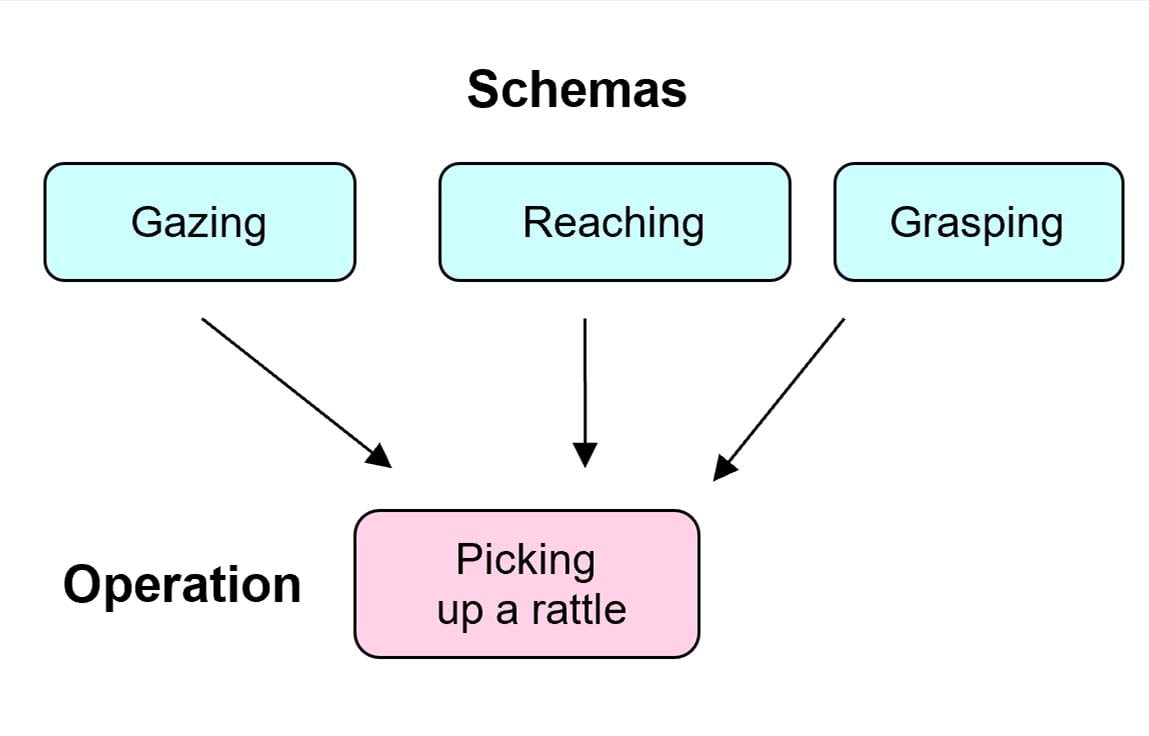
Piaget emphasized the importance of schemas in cognitive development and described how they were developed or acquired.
A schema can be defined as a set of linked mental representations of the world, which we use both to understand and to respond to situations. The assumption is that we store these mental representations and apply them when needed.
Examples of Schemas
A person might have a schema about buying a meal in a restaurant. The schema is a stored form of the pattern of behavior which includes looking at a menu, ordering food, eating it and paying the bill.
This is an example of a schema called a “script.” Whenever they are in a restaurant, they retrieve this schema from memory and apply it to the situation.
The schemas Piaget described tend to be simpler than this – especially those used by infants. He described how – as a child gets older – his or her schemas become more numerous and elaborate.
Piaget believed that newborn babies have a small number of innate schemas – even before they have had many opportunities to experience the world. These neonatal schemas are the cognitive structures underlying innate reflexes. These reflexes are genetically programmed into us.
For example, babies have a sucking reflex, which is triggered by something touching the baby’s lips. A baby will suck a nipple, a comforter (dummy), or a person’s finger. Piaget, therefore, assumed that the baby has a “sucking schema.”
Similarly, the grasping reflex which is elicited when something touches the palm of a baby’s hand, or the rooting reflex, in which a baby will turn its head towards something which touches its cheek, are innate schemas. Shaking a rattle would be the combination of two schemas, grasping and shaking.
4. The Process of Adaptation
Piaget also believed that a child developed as a result of two different influences: maturation, and interaction with the environment. The child develops mental structures (schemata) which enables him to solve problems in the environment.
Adaptation is the process by which the child changes its mental models of the world to match more closely how the world actually is.
Adaptation is brought about by the processes of assimilation (solving new experiences using existing schemata) and accommodation (changing existing schemata in order to solve new experiences).
The importance of this viewpoint is that the child is seen as an active participant in its own development rather than a passive recipient of either biological influences (maturation) or environmental stimulation.
When our existing schemas can explain what we perceive around us, we are in a state of equilibration . However, when we meet a new situation that we cannot explain it creates disequilibrium, this is an unpleasant sensation which we try to escape, and this gives us the motivation to learn.
According to Piaget, reorganization to higher levels of thinking is not accomplished easily. The child must “rethink” his or her view of the world. An important step in the process is the experience of cognitive conflict.
In other words, the child becomes aware that he or she holds two contradictory views about a situation and they both cannot be true. This step is referred to as disequilibrium .
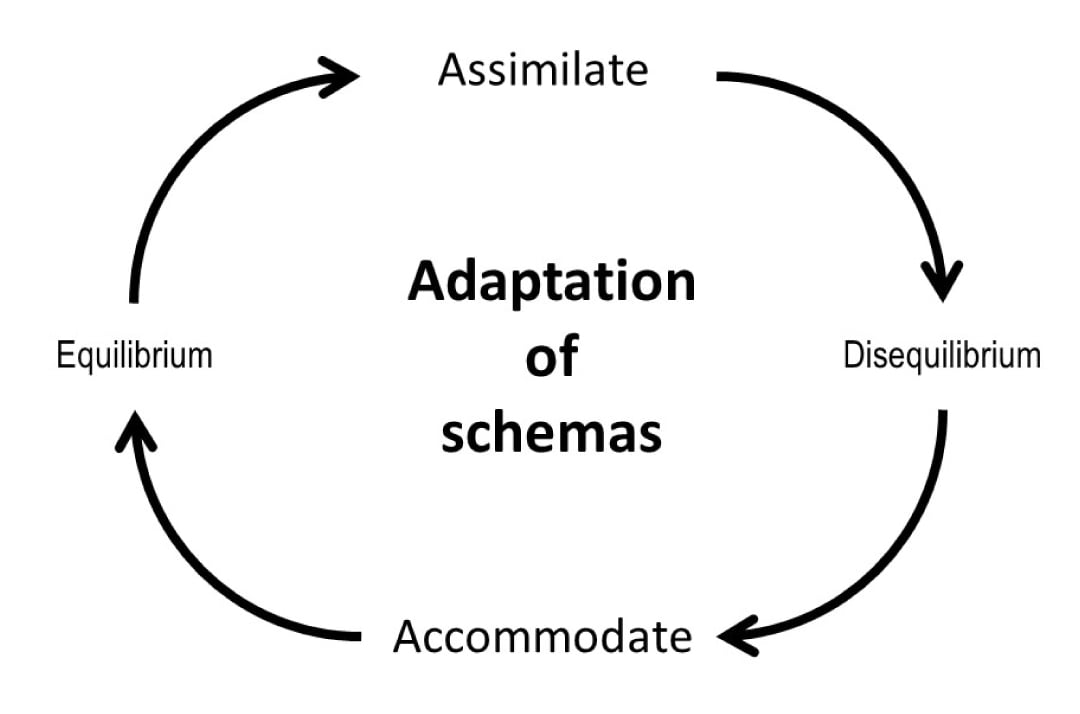
Jean Piaget (1952; see also Wadsworth, 2004) viewed intellectual growth as a process of adaptation (adjustment) to the world. This happens through assimilation, accommodation, and equilibration.
To get back to a state of equilibration, we need to modify our existing schemas to learn and adapt to the new situation.
This is done through the processes of accommodation and assimilation . This is how our schemas evolve and become more sophisticated. The processes of assimilation and accommodation are continuous and interactive.
5. Assimilation
Piaget defined assimilation as the cognitive process of fitting new information into existing cognitive schemas, perceptions, and understanding. Overall beliefs and understanding of the world do not change as a result of the new information.
Assimilation occurs when the new experience is not very different from previous experiences of a particular object or situation we assimilate the new situation by adding information to a previous schema.
This means that when you are faced with new information, you make sense of this information by referring to information you already have (information processed and learned previously) and trying to fit the new information into the information you already have.
- Imagine a young child who has only ever seen small, domesticated dogs. When the child sees a cat for the first time, they might refer to it as a “dog” because it has four legs, fur, and a tail – features that fit their existing schema of a dog.
- A person who has always believed that all birds can fly might label penguins as birds that can fly. This is because their existing schema or understanding of birds includes the ability to fly.
- A 2-year-old child sees a man who is bald on top of his head and has long frizzy hair on the sides. To his father’s horror, the toddler shouts “Clown, clown” (Siegler et al., 2003).
- If a baby learns to pick up a rattle he or she will then use the same schema (grasping) to pick up other objects.
6. Accommodation
Accommodation: when the new experience is very different from what we have encountered before we need to change our schemas in a very radical way or create a whole new schema.
Psychologist Jean Piaget defined accommodation as the cognitive process of revising existing cognitive schemas, perceptions, and understanding so that new information can be incorporated.
This happens when the existing schema (knowledge) does not work, and needs to be changed to deal with a new object or situation.
In order to make sense of some new information, you actually adjust information you already have (schemas you already have, etc.) to make room for this new information.
- A baby tries to use the same schema for grasping to pick up a very small object. It doesn’t work. The baby then changes the schema by now using the forefinger and thumb to pick up the object.
- A child may have a schema for birds (feathers, flying, etc.) and then they see a plane, which also flies, but would not fit into their bird schema.
- In the “clown” incident, the boy’s father explained to his son that the man was not a clown and that even though his hair was like a clown’s, he wasn’t wearing a funny costume and wasn’t doing silly things to make people laugh. With this new knowledge, the boy was able to change his schema of “clown” and make this idea fit better to a standard concept of “clown”.
- A person who grew up thinking all snakes are dangerous might move to an area where garden snakes are common and harmless. Over time, after observing and learning, they might accommodate their previous belief to understand that not all snakes are harmful.
7. Equilibration
Piaget believed that all human thought seeks order and is uncomfortable with contradictions and inconsistencies in knowledge structures. In other words, we seek “equilibrium” in our cognitive structures.
Equilibrium occurs when a child’s schemas can deal with most new information through assimilation. However, an unpleasant state of disequilibrium occurs when new information cannot be fitted into existing schemas (assimilation).
Piaget believed that cognitive development did not progress at a steady rate, but rather in leaps and bounds. Equilibration is the force which drives the learning process as we do not like to be frustrated and will seek to restore balance by mastering the new challenge (accommodation).
Once the new information is acquired the process of assimilation with the new schema will continue until the next time we need to make an adjustment to it.
Equilibration is a regulatory process that maintains a balance between assimilation and accommodation to facilitate cognitive growth. Think of it this way: We can’t merely assimilate all the time; if we did, we would never learn any new concepts or principles.
Everything new we encountered would just get put in the same few “slots” we already had. Neither can we accommodate all the time; if we did, everything we encountered would seem new; there would be no recurring regularities in our world. We’d be exhausted by the mental effort!
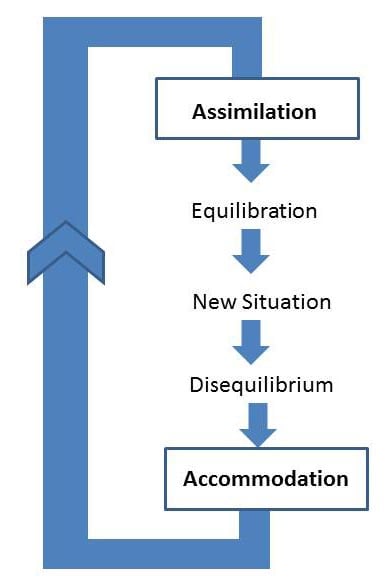
Applications to Education
Think of old black and white films that you’ve seen in which children sat in rows at desks, with ink wells, would learn by rote, all chanting in unison in response to questions set by an authoritarian old biddy like Matilda!
Children who were unable to keep up were seen as slacking and would be punished by variations on the theme of corporal punishment. Yes, it really did happen and in some parts of the world still does today.
Piaget is partly responsible for the change that occurred in the 1960s and for your relatively pleasurable and pain-free school days!
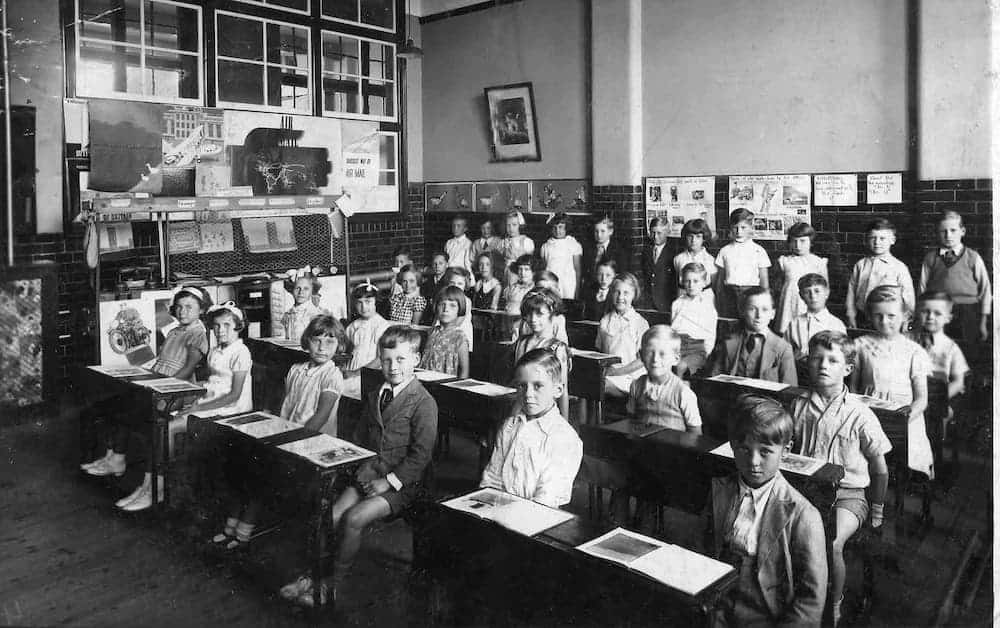
“Children should be able to do their own experimenting and their own research. Teachers, of course, can guide them by providing appropriate materials, but the essential thing is that in order for a child to understand something, he must construct it himself, he must re-invent it. Every time we teach a child something, we keep him from inventing it himself. On the other hand that which we allow him to discover by himself will remain with him visibly”. Piaget (1972, p. 27)
Plowden Report
Piaget (1952) did not explicitly relate his theory to education, although later researchers have explained how features of Piaget’s theory can be applied to teaching and learning.
Piaget has been extremely influential in developing educational policy and teaching practice. For example, a review of primary education by the UK government in 1966 was based strongly on Piaget’s theory. The result of this review led to the publication of the Plowden Report (1967).
In the 1960s the Plowden Committee investigated the deficiencies in education and decided to incorporate many of Piaget’s ideas into its final report published in 1967, even though Piaget’s work was not really designed for education.
The report makes three Piaget-associated recommendations:
- Children should be given individual attention and it should be realized that they need to be treated differently.
- Children should only be taught things that they are capable of learning
- Children mature at different rates and the teacher needs to be aware of the stage of development of each child so teaching can be tailored to their individual needs.
“The report’s recurring themes are individual learning, flexibility in the curriculum, the centrality of play in children’s learning, the use of the environment, learning by discovery and the importance of the evaluation of children’s progress – teachers should “not assume that only what is measurable is valuable.”
Discovery learning – the idea that children learn best through doing and actively exploring – was seen as central to the transformation of the primary school curriculum.
How to teach
Within the classroom learning should be student-centered and accomplished through active discovery learning. The role of the teacher is to facilitate learning, rather than direct tuition.
Because Piaget’s theory is based upon biological maturation and stages, the notion of “readiness” is important. Readiness concerns when certain information or concepts should be taught.
According to Piaget’s theory, children should not be taught certain concepts until they have reached the appropriate stage of cognitive development.
According to Piaget (1958), assimilation and accommodation require an active learner, not a passive one, because problem-solving skills cannot be taught, they must be discovered.
Therefore, teachers should encourage the following within the classroom:
- Educational programs should be designed to correspond to Piaget’s stages of development. Children in the concrete operational stage should be given concrete means to learn new concepts e.g. tokens for counting.
- Devising situations that present useful problems, and create disequilibrium in the child.
- Focus on the process of learning, rather than the end product of it. Instead of checking if children have the right answer, the teacher should focus on the student’s understanding and the processes they used to get to the answer.
- Child-centered approach. Learning must be active (discovery learning). Children should be encouraged to discover for themselves and to interact with the material instead of being given ready-made knowledge.
- Accepting that children develop at different rates so arrange activities for individual children or small groups rather than assume that all the children can cope with a particular activity.
- Using active methods that require rediscovering or reconstructing “truths.”
- Using collaborative, as well as individual activities (so children can learn from each other).
- Evaluate the level of the child’s development so suitable tasks can be set.
- Adapt lessons to suit the needs of the individual child (i.e. differentiated teaching).
- Be aware of the child’s stage of development (testing).
- Teach only when the child is ready. i.e. has the child reached the appropriate stage.
- Providing support for the “spontaneous research” of the child.
- Using collaborative, as well as individual activities.
- Educators may use Piaget’s stages to design age-appropriate assessment tools and strategies.
Classroom Activities
Sensorimotor stage (0-2 years):.
Although most kids in this age range are not in a traditional classroom setting, they can still benefit from games that stimulate their senses and motor skills.
- Object Permanence Games : Play peek-a-boo or hide toys under a blanket to help babies understand that objects still exist even when they can’t see them.
- Sensory Play : Activities like water play, sand play, or playdough encourage exploration through touch.
- Imitation : Children at this age love to imitate adults. Use imitation as a way to teach new skills.
Preoperational Stage (2-7 years):
- Role Playing : Set up pretend play areas where children can act out different scenarios, such as a kitchen, hospital, or market.
- Use of Symbols : Encourage drawing, building, and using props to represent other things.
- Hands-on Activities : Children should interact physically with their environment, so provide plenty of opportunities for hands-on learning.
- Egocentrism Activities : Use exercises that highlight different perspectives. For instance, having two children sit across from each other with an object in between and asking them what the other sees.
Concrete Operational Stage (7-11 years):
- Classification Tasks : Provide objects or pictures to group, based on various characteristics.
- Hands-on Experiments : Introduce basic science experiments where they can observe cause and effect, like a simple volcano with baking soda and vinegar.
- Logical Games : Board games, puzzles, and logic problems help develop their thinking skills.
- Conservation Tasks : Use experiments to showcase that quantity doesn’t change with alterations in shape, such as the classic liquid conservation task using different shaped glasses.
Formal Operational Stage (11 years and older):
- Hypothesis Testing : Encourage students to make predictions and test them out.
- Abstract Thinking : Introduce topics that require abstract reasoning, such as algebra or ethical dilemmas.
- Problem Solving : Provide complex problems and have students work on solutions, integrating various subjects and concepts.
- Debate and Discussion : Encourage group discussions and debates on abstract topics, highlighting the importance of logic and evidence.
- Feedback and Questioning : Use open-ended questions to challenge students and promote higher-order thinking. For instance, rather than asking, “Is this the right answer?”, ask, “How did you arrive at this conclusion?”
While Piaget’s stages offer a foundational framework, they are not universally experienced in the same way by all children.
Social identities play a critical role in shaping cognitive development, necessitating a more nuanced and culturally responsive approach to understanding child development.
Piaget’s stages may manifest differently based on social identities like race, gender, and culture:
- Race & Teacher Interactions : A child’s race can influence teacher expectations and interactions. For example, racial biases can lead to children of color being perceived as less capable or more disruptive, influencing their cognitive challenges and supports.
- Racial and Cultural Stereotypes : These can affect a child’s self-perception and self-efficacy . For instance, stereotypes about which racial or cultural groups are “better” at certain subjects can influence a child’s self-confidence and, subsequently, their engagement in that subject.
- Gender & Peer Interactions : Children learn gender roles from their peers. Boys might be mocked for playing “girl games,” and girls might be excluded from certain activities, influencing their cognitive engagements.
- Language : Multilingual children might navigate the stages differently, especially if their home language differs from their school language. The way concepts are framed in different languages can influence cognitive processing. Cultural idioms and metaphors can shape a child’s understanding of concepts and their ability to use symbolic representation, especially in the pre-operational stage.
Curriculum Development
According to Piaget, children’s cognitive development is determined by a process of maturation which cannot be altered by tuition so education should be stage-specific.
For example, a child in the concrete operational stage should not be taught abstract concepts and should be given concrete aid such as tokens to count with.
According to Piaget children learn through the process of accommodation and assimilation so the role of the teacher should be to provide opportunities for these processes to occur such as new material and experiences that challenge the children’s existing schemas.
Furthermore, according to this theory, children should be encouraged to discover for themselves and to interact with the material instead of being given ready-made knowledge.
Curricula need to be developed that take into account the age and stage of thinking of the child. For example there is no point in teaching abstract concepts such as algebra or atomic structure to children in primary school.
Curricula also need to be sufficiently flexible to allow for variations in the ability of different students of the same age. In Britain, the National Curriculum and Key Stages broadly reflect the stages that Piaget laid down.
For example, egocentrism dominates a child’s thinking in the sensorimotor and preoperational stages. Piaget would therefore predict that using group activities would not be appropriate since children are not capable of understanding the views of others.
However, Smith et al. (1998), point out that some children develop earlier than Piaget predicted and that by using group work children can learn to appreciate the views of others in preparation for the concrete operational stage.
The national curriculum emphasizes the need to use concrete examples in the primary classroom.
Shayer (1997), reported that abstract thought was necessary for success in secondary school (and co-developed the CASE system of teaching science). Recently the National curriculum has been updated to encourage the teaching of some abstract concepts towards the end of primary education, in preparation for secondary courses. (DfEE, 1999).
Child-centered teaching is regarded by some as a child of the ‘liberal sixties.’ In the 1980s the Thatcher government introduced the National Curriculum in an attempt to move away from this and bring more central government control into the teaching of children.
So, although the British National Curriculum in some ways supports the work of Piaget, (in that it dictates the order of teaching), it can also be seen as prescriptive to the point where it counters Piaget’s child-oriented approach.
However, it does still allow for flexibility in teaching methods, allowing teachers to tailor lessons to the needs of their students.
Social Media (Digital Learning)
Jean Piaget could not have anticipated the expansive digital age we now live in.
Today, knowledge dissemination and creation are democratized by the Internet, with platforms like blogs, wikis, and social media allowing for vast collaboration and shared knowledge. This development has prompted a reimagining of the future of education.
Classrooms, traditionally seen as primary sites of learning, are being overshadowed by the rise of mobile technologies and platforms like MOOCs (Passey, 2013).
The millennial generation, defined as the first to grow up with cable TV, the internet, and cell phones, relies heavily on technology.
They view it as an integral part of their identity, with most using it extensively in their daily lives, from keeping in touch with loved ones to consuming news and entertainment (Nielsen, 2014).
Social media platforms offer a dynamic environment conducive to Piaget’s principles. These platforms allow for interactions that nurture knowledge evolution through cognitive processes like assimilation and accommodation.
They emphasize communal interaction and shared activity, fostering both cognitive and socio-cultural constructivism. This shared activity promotes understanding and exploration beyond individual perspectives, enhancing social-emotional learning (Gehlbach, 2010).
A standout advantage of social media in an educational context is its capacity to extend beyond traditional classroom confines. As the material indicates, these platforms can foster more inclusive learning, bridging diverse learner groups.
This inclusivity can equalize learning opportunities, potentially diminishing biases based on factors like race or socio-economic status, resonating with Kegan’s (1982) concept of “recruitability.”
However, there are challenges. While the potential of social media in learning is vast, its practical application necessitates intention and guidance. Cuban, Kirkpatrick, and Peck (2001) note that certain educators and students are hesitant about integrating social media into educational contexts.
This hesitancy can stem from technological complexities or potential distractions. Yet, when harnessed effectively, social media can provide a rich environment for collaborative learning and interpersonal development, fostering a deeper understanding of content.
In essence, the rise of social media aligns seamlessly with constructivist philosophies. Social media platforms act as tools for everyday cognition, merging daily social interactions with the academic world, and providing avenues for diverse, interactive, and engaging learning experiences.
Applications to Parenting
Parents can use Piaget’s stages to have realistic developmental expectations of their children’s behavior and cognitive capabilities.
For instance, understanding that a toddler is in the pre-operational stage can help parents be patient when the child is egocentric.
Play Activities
Recognizing the importance of play in cognitive development, many parents provide toys and games suited for their child’s developmental stage.
Parents can offer activities that are slightly beyond their child’s current abilities, leveraging Vygotsky’s concept of the “Zone of Proximal Development,” which complements Piaget’s ideas.
- Peek-a-boo : Helps with object permanence.
- Texture Touch : Provide different textured materials (soft, rough, bumpy, smooth) for babies to touch and feel.
- Sound Bottles : Fill small bottles with different items like rice, beans, bells, and have children shake and listen to the different sounds.
- Memory Games : Using cards with pictures, place them face down, and ask students to find matching pairs.
- Role Playing and Pretend Play : Let children act out roles or stories that enhance symbolic thinking. Encourage symbolic play with dress-up clothes, playsets, or toy cash registers. Provide prompts or scenarios to extend their imagination.
- Story Sequencing : Give children cards with parts of a story and have them arranged in the correct order.
- Number Line Jumps : Create a number line on the floor with tape. Ask students to jump to the correct answer for math problems.
- Classification Games : Provide a mix of objects and ask students to classify them based on different criteria (e.g., color, size, shape).
- Logical Puzzle Games : Games that involve problem-solving using logic, such as simple Sudoku puzzles or logic grid puzzles.
- Debate and Discussion : Provide a topic and let students debate on pros and cons. This promotes abstract thinking and logical reasoning.
- Hypothesis Testing Games : Present a scenario and have students come up with hypotheses and ways to test them.
- Strategy Board Games : Games like chess, checkers, or Settlers of Catan can help in developing strategic and forward-thinking skills.
Critical Evaluation
- The influence of Piaget’s ideas on developmental psychology has been enormous. He changed how people viewed the child’s world and their methods of studying children.
He was an inspiration to many who came after and took up his ideas. Piaget’s ideas have generated a huge amount of research which has increased our understanding of cognitive development.
- Piaget (1936) was one of the first psychologists to make a systematic study of cognitive development. His contributions include a stage theory of child cognitive development, detailed observational studies of cognition in children, and a series of simple but ingenious tests to reveal different cognitive abilities.
- His ideas have been of practical use in understanding and communicating with children, particularly in the field of education (re: Discovery Learning). Piaget’s theory has been applied across education.
- According to Piaget’s theory, educational programs should be designed to correspond to the stages of development.
- Are the stages real? Vygotsky and Bruner would rather not talk about stages at all, preferring to see development as a continuous process. Others have queried the age ranges of the stages. Some studies have shown that progress to the formal operational stage is not guaranteed.
For example, Keating (1979) reported that 40-60% of college students fail at formal operation tasks, and Dasen (1994) states that only one-third of adults ever reach the formal operational stage.
The fact that the formal operational stage is not reached in all cultures and not all individuals within cultures suggests that it might not be biologically based.
- According to Piaget, the rate of cognitive development cannot be accelerated as it is based on biological processes however, direct tuition can speed up the development which suggests that it is not entirely based on biological factors.
- Because Piaget concentrated on the universal stages of cognitive development and biological maturation, he failed to consider the effect that the social setting and culture may have on cognitive development.
Cross-cultural studies show that the stages of development (except the formal operational stage) occur in the same order in all cultures suggesting that cognitive development is a product of a biological process of maturation.
However, the age at which the stages are reached varies between cultures and individuals which suggests that social and cultural factors and individual differences influence cognitive development.
Dasen (1994) cites studies he conducted in remote parts of the central Australian desert with 8-14-year-old Indigenous Australians. He gave them conservation of liquid tasks and spatial awareness tasks. He found that the ability to conserve came later in the Aboriginal children, between ages of 10 and 13 (as opposed to between 5 and 7, with Piaget’s Swiss sample).
However, he found that spatial awareness abilities developed earlier amongst the Aboriginal children than the Swiss children. Such a study demonstrates cognitive development is not purely dependent on maturation but on cultural factors too – spatial awareness is crucial for nomadic groups of people.
Vygotsky , a contemporary of Piaget, argued that social interaction is crucial for cognitive development. According to Vygotsky the child’s learning always occurs in a social context in cooperation with someone more skillful (MKO). This social interaction provides language opportunities and Vygotsky considered language the foundation of thought.
- Piaget’s methods (observation and clinical interviews) are more open to biased interpretation than other methods. Piaget made careful, detailed naturalistic observations of children, and from these, he wrote diary descriptions charting their development. He also used clinical interviews and observations of older children who were able to understand questions and hold conversations.
Because Piaget conducted the observations alone the data collected are based on his own subjective interpretation of events. It would have been more reliable if Piaget conducted the observations with another researcher and compared the results afterward to check if they are similar (i.e., have inter-rater reliability).
Although clinical interviews allow the researcher to explore data in more depth, the interpretation of the interviewer may be biased.
For example, children may not understand the question/s, they have short attention spans, they cannot express themselves very well, and may be trying to please the experimenter. Such methods meant that Piaget may have formed inaccurate conclusions.
- As several studies have shown Piaget underestimated the abilities of children because his tests were sometimes confusing or difficult to understand (e.g., Hughes , 1975).
Piaget failed to distinguish between competence (what a child is capable of doing) and performance (what a child can show when given a particular task). When tasks were altered, performance (and therefore competence) was affected. Therefore, Piaget might have underestimated children’s cognitive abilities.
For example, a child might have object permanence (competence) but still not be able to search for objects (performance). When Piaget hid objects from babies he found that it wasn’t till after nine months that they looked for it.
However, Piaget relied on manual search methods – whether the child was looking for the object or not.
Later, researchers such as Baillargeon and Devos (1991) reported that infants as young as four months looked longer at a moving carrot that didn’t do what it expected, suggesting they had some sense of permanence, otherwise they wouldn’t have had any expectation of what it should or shouldn’t do.
- The concept of schema is incompatible with the theories of Bruner (1966) and Vygotsky (1978). Behaviorism would also refute Piaget’s schema theory because is cannot be directly observed as it is an internal process. Therefore, they would claim it cannot be objectively measured.
- Piaget studied his own children and the children of his colleagues in Geneva to deduce general principles about the intellectual development of all children. His sample was very small and composed solely of European children from families of high socio-economic status. Researchers have, therefore, questioned the generalisability of his data.
- For Piaget, language is considered secondary to action, i.e., thought precedes language. The Russian psychologist Lev Vygotsky (1978) argues that the development of language and thought go together and that the origin of reasoning has more to do with our ability to communicate with others than with our interaction with the material world.
Piaget’s Theory vs Vygotsky
Piaget maintains that cognitive development stems largely from independent explorations in which children construct knowledge of their own.
Whereas Vygotsky argues that children learn through social interactions, building knowledge by learning from more knowledgeable others such as peers and adults. In other words, Vygotsky believed that culture affects cognitive development.
These factors lead to differences in the education style they recommend: Piaget would argue for the teacher to provide opportunities that challenge the children’s existing schemas and for children to be encouraged to discover for themselves.
Alternatively, Vygotsky would recommend that teachers assist the child to progress through the zone of proximal development by using scaffolding.
However, both theories view children as actively constructing their own knowledge of the world; they are not seen as just passively absorbing knowledge.
They also agree that cognitive development involves qualitative changes in thinking, not only a matter of learning more things.
What is cognitive development?
Cognitive development is how a person’s ability to think, learn, remember, problem-solve, and make decisions changes over time.
This includes the growth and maturation of the brain, as well as the acquisition and refinement of various mental skills and abilities.
Cognitive development is a major aspect of human development, and both genetic and environmental factors heavily influence it. Key domains of cognitive development include attention, memory, language skills, logical reasoning, and problem-solving.
Various theories, such as those proposed by Jean Piaget and Lev Vygotsky, provide different perspectives on how this complex process unfolds from infancy through adulthood.
What are the 4 stages of Piaget’s theory?
Piaget divided children’s cognitive development into four stages; each of the stages represents a new way of thinking and understanding the world.
He called them (1) sensorimotor intelligence , (2) preoperational thinking , (3) concrete operational thinking , and (4) formal operational thinking . Each stage is correlated with an age period of childhood, but only approximately.
According to Piaget, intellectual development takes place through stages that occur in a fixed order and which are universal (all children pass through these stages regardless of social or cultural background).
Development can only occur when the brain has matured to a point of “readiness”.
What are some of the weaknesses of Piaget’s theory?
Cross-cultural studies show that the stages of development (except the formal operational stage) occur in the same order in all cultures suggesting that cognitive development is a product of a biological maturation process.
However, the age at which the stages are reached varies between cultures and individuals, suggesting that social and cultural factors and individual differences influence cognitive development.
What are Piaget’s concepts of schemas?
Schemas are mental structures that contain all of the information relating to one aspect of the world around us.
According to Piaget, we are born with a few primitive schemas, such as sucking, which give us the means to interact with the world.
These are physical, but as the child develops, they become mental schemas. These schemas become more complex with experience.
Baillargeon, R., & DeVos, J. (1991). Object permanence in young infants: Further evidence . Child development , 1227-1246.
Bruner, J. S. (1966). Toward a theory of instruction. Cambridge, Mass.: Belkapp Press.
Cuban, L., Kirkpatrick, H., & Peck, C. (2001). High access and low use of technologies in high school classrooms: Explaining an apparent paradox. American Educational Research Journal , 38 (4), 813-834.
Dasen, P. (1994). Culture and cognitive development from a Piagetian perspective. In W .J. Lonner & R.S. Malpass (Eds.), Psychology and culture (pp. 145–149). Boston, MA: Allyn and Bacon.
Gehlbach, H. (2010). The social side of school: Why teachers need social psychology. Educational Psychology Review , 22 , 349-362.
Hughes, M. (1975). Egocentrism in preschool children . Unpublished doctoral dissertation. Edinburgh University.
Inhelder, B., & Piaget, J. (1958). The growth of logical thinking from childhood to adolescence . New York: Basic Books.
Keating, D. (1979). Adolescent thinking. In J. Adelson (Ed.), Handbook of adolescent psychology (pp. 211-246). New York: Wiley.
Kegan, R. (1982). The evolving self: Problem and process in human development . Harvard University Press.
Nielsen. 2014. “Millennials: Technology = Social Connection.” http://www.nielsen.com/content/corporate/us/en/insights/news/2014/millennials-technology-social-connecti on.html.
Passey, D. (2013). Inclusive technology enhanced learning: Overcoming cognitive, physical, emotional, and geographic challenges . Routledge.
Piaget, J. (1932). The moral judgment of the child . London: Routledge & Kegan Paul.
Piaget, J. (1936). Origins of intelligence in the child. London: Routledge & Kegan Paul.
Piaget, J. (1945). Play, dreams and imitation in childhood . London: Heinemann.
Piaget, J. (1957). Construction of reality in the child. London: Routledge & Kegan Paul.
Piaget, J., & Cook, M. T. (1952). The origins of intelligence in children . New York, NY: International University Press.
Piaget, J. (1981). Intelligence and affectivity: Their relationship during child development.(Trans & Ed TA Brown & CE Kaegi) . Annual Reviews.
Plowden, B. H. P. (1967). Children and their primary schools: A report (Research and Surveys). London, England: HM Stationery Office.
Siegler, R. S., DeLoache, J. S., & Eisenberg, N. (2003). How children develop . New York: Worth.
Vygotsky, L. S. (1978). Mind in society: The development of higher psychological processes . Cambridge, MA: Harvard University Press.
Wadsworth, B. J. (2004). Piaget’s theory of cognitive and affective development: Foundations of constructivism . New York: Longman.
Further Reading
- BBC Radio Broadcast about the Three Mountains Study
- Piagetian stages: A critical review
- Bronfenbrenner’s Ecological Systems Theory
Related Articles

Child Psychology
Vygotsky vs. Piaget: A Paradigm Shift

Interactional Synchrony

Internal Working Models of Attachment

Soft Determinism In Psychology

Branches of Psychology
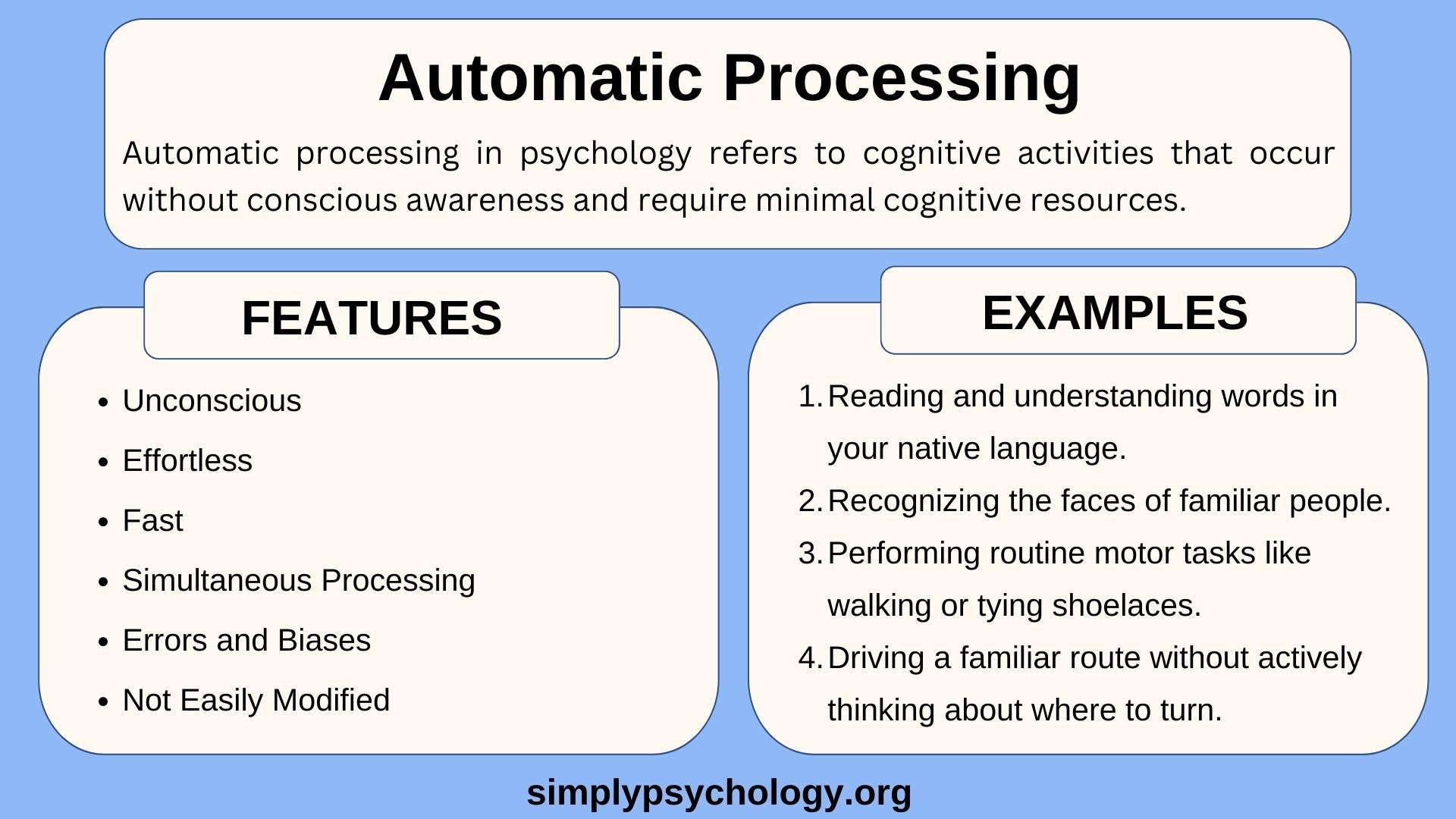
Cognitive Psychology
Automatic Processing in Psychology: Definition & Examples
Piaget’s Stages: 4 Stages of Cognitive Development & Theory

You’re trying to explain something to a child, and even though it seems so obvious to you, the child just doesn’t seem to understand.
They repeat the same mistake, over and over, and you become increasingly frustrated.
Well, guess what?
- The child is not naughty.
- They’re also not stupid.
- But their lack of understanding is not your fault either.
Their cognitive development limits their ability to understand certain concepts. Specifically, they’re not capable right now of understanding what you’re trying to explain.
In this post, we’ll learn more about Jean Piaget, a famous psychologist whose ideas about cognitive development in children were extremely influential. We’ll cover quite a lot in this post, so make sure you have a cup of coffee and you’re sitting somewhere comfortable.
Before you continue, we thought you might like to download our three Positive Psychology Exercises for free . These science-based exercises explore fundamental aspects of positive psychology, including strengths, values, and self-compassion, and will give you the tools to enhance the wellbeing of your clients, students, or employees.
This Article Contains:
Who was jean piaget in psychology, piaget’s cognitive development theory, 1. the sensorimotor stage, 2. the preoperational stage, 3. the concrete operational stage, 4. the formal operational stage, piaget’s theory vs erikson’s, 5 important concepts in piaget’s work, applications in education (+3 classroom games), positivepsychology.com’s relevant resources, a take-home message.
Jean Piaget was a Swiss psychologist who contributed greatly to the understanding of children’s cognitive development (Papalia & Feldman, 2011; Waite-Stupiansky, 2017).
He was born in 1896 and originally trained as a biologist and philosopher. Although he is well known for his work as a psychologist, he also published research on sparrows and mollusks (Burman, 2012; Papalia & Feldman, 2011; Waite-Stupiansky, 2017).
Piaget’s contribution to psychology was mainly through his observations of children’s cognitive development (Papalia & Feldman, 2011). Early in his career, Piaget scored the IQ tests that Alfred Binet administered to children.
Piaget noticed that children of certain ages tended to give the same types of incorrect answers. From these observations and follow-up interviews with children about these mistakes, he developed a theory of how children’s cognitive processes developed (Waite-Stupiansky, 2017).
One of the most important implications of his work is that children are not born with the same cognitive processes as adults (Papalia & Feldman, 2011). Instead, children’s cognitive processes:
- develop over time,
- develop in response to their environment, and
- are updated with exposure to new information.
Piaget also influenced psychology in other ways. For example, he emphasized other methods of conducting research, such as the clinical method (Papalia & Feldman, 2011; Waite-Stupiansky, 2017). He relied upon the following research methods:
- Naturalistic observation of play and conversation between children (including his own)
- Interviewing children
Additionally, he was the first psychologist to study ‘theory of mind’ in children (Papalia & Feldman, 2011). Theory of mind is the understanding or basic sense that each of us has our own consciousness and thoughts.
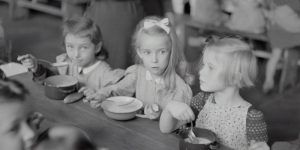
Specifically, he posited that as children’s thinking develops from one stage to the next, their behavior also changes, reflecting these cognitive developments.
The stages in his theory follow a specific order, and each subsequent stage only occurs after the one before it.
These stages are:
- Sensorimotor stage (0–2 years old)
- Preoperational stage (2–7 years old)
- Concrete operational stage (7–11 years old)
- Formal operational stage (11 years old through adulthood)

Download 3 Free Positive Psychology Exercises (PDF)
Enhance wellbeing with these free, science-based exercises that draw on the latest insights from positive psychology.
Download 3 Free Positive Psychology Tools Pack (PDF)
By filling out your name and email address below.
The sensorimotor stage is the first phase of children’s cognitive development. During this stage, children primarily learn about their environment through their senses and motor activities.
The sensorimotor stage comprises six substages, where children’s behavior moves from being reflex driven to more abstract. Each substage is described briefly.
1. Use of reflexes (0–2 months)
During this stage, children typically use their reflexes. They cannot consolidate information from their sensory organs into a single, unified concept.
2. Primary circular reactions (1–4 months)
Children start to consolidate information from different sensory organs. They start to engage in behavior that satisfies the way their body feels or their needs. For example, they repeat pleasurable behaviors, and they adapt their behavior to feed from different objects. They turn to respond to sounds and sights in their environment.
3. Secondary circular reactions (4–8 months)
Children’s behaviors become more intentional, and the types of behaviors that they repeat expand to include those that result in interesting responses external to their body. For example, they might push buttons on a toy. Children also start to take more interest in their environment. They repeat behaviors that generate interesting responses.
4. Coordination of secondary schemes (8–12 months)
At this point, children’s behaviors become more goal oriented, and they can combine different behaviors to achieve goals.
5. Tertiary circular reactions (12–18 months)
Instead of performing the same actions, children try new behaviors and actions to achieve different results. These behaviors are not spontaneous or by accident, but are purposeful. Unlike primary and secondary reactions, children can combine more complicated behaviors and even perform a behavior similarly but not the same to get the desired result.
6. Mental combinations (18–24 months)
Children start to rely on mental abstractions to solve problems, use gestures and words to communicate, and can pretend. Instead of relying on numerous attempts to solve problems/puzzles, children can deliberate and carefully choose their actions.

At the age of two, children enter the preoperational stage, where their ability to use mental representations, rather than the physical appearance of objects or people, improves greatly.
Examples of abstract representations include engaging in pretend play and talking about events that happened in the past or people who are not currently in the room.
Other interesting cognitive advances occur during this phase. For example, children understand causality. Children also understand identities, where items and people remain the same even if they look different. For example, at some point during this stage, a caregiver dressing up as Santa Claus might not be as convincing.
In this stage, children also learn more about categorization. They can classify items based on similarities or differences. They also start to understand numbers and quantity (e.g., concepts such as ‘more’ or ‘bigger’).
Although abstract thought advances quickly in the preoperational stage, other cognitive processes develop more slowly.
For example:
- Children tend to consider their own viewpoint and perspective.
- Children fail to understand that two things can be the same, even if they appear different (more about this in the next section on Conservation).
- Children struggle to take someone else’s point of view.
The next phase is the concrete operational stage, which begins around the age of seven. During this stage, children are more capable of solving problems because they can consider numerous outcomes and perspectives. All of their cognitive abilities are better developed in this stage.
- Categorization abilities improve so that children can arrange items along a dimension, understand that categories have subcategories, and relate two objects to each other through a third object.
- Their numerical abilities improve a lot, and they can perform more complicated mathematical operations.
- Their spatial abilities are better. They are better at estimating time and distance. They can read maps and describe how to navigate from one location to another.
Conservation
During this stage, children understand the concept of conservation better and, as a result, are better at solving conservation problems. Conservation refers to the idea that things can be the same, even if they look different.
An example would be a cup of water poured into two glasses. One glass is tall and thin, while the other is short and wide. Recognizing that both glasses contain the same amount of water shows an understanding of conservation.
Children in the preoperational stage struggle with problems of conservation. For example, they struggle with tasks where the following is conserved even it appears different:
- Number of items (e.g., two sets of 10 items arranged differently)
- The volume of liquid (e.g., the same volume of liquid in two differently shaped glasses)
Children struggle with conservation because they can only focus on one dimension at a time; this is known as centering. For example, with the volume of liquid, they can only consider the shape of the glass, but not the shape of the glass and the volume of water.
They also do not yet understand reversibility. Irreversibility refers to a child’s inability to reverse the steps of an action in their mind, returning an object to its previous state. For example, pouring the water out of the glass back into the original cup would demonstrate the volume of the water, but children in the preoperational stage cannot understand this.
In contrast, children in the concrete operational stage can solve conservation problems. This is because children now have the following cognitive abilities:
- They understand reversibility (i.e., items can be returned to original states).
- They can decenter (i.e., concentrate on multiple dimensions of items, rather than just one).
- They better understand identity (i.e., an item remains the same even if it looks different).

Abstract thought characterizes this stage. Children can think about abstract concepts and are not limited to a current time, person, or situation.
They can think about hypothetical situations and various possibilities, like situations that don’t exist yet, may never exist, or might be unrealistic and fantastical.
During this stage, children are capable of hypothetical-deductive reasoning, which allows them to test hypotheses and draw conclusions from the results. Unlike younger children who haphazardly approach problems, children in the formal operational stage can apply their reasoning skills to apply more complicated problems in a systematic, logical manner.
Piaget’s theory of cognitive development is one of several theories about how children develop. Other contrasting theories include Vygotsky’s sociocultural theory, Freud’s psychoanalytic theory, and importantly for this post, Erikson’s psychosocial theory of development.
Differences
Unlike Piaget, who focused on cognitive development, Erikson emphasized healthy ego development (Papalia & Feldman, 2011). Healthy egos are developed when people resolve specific personality issues at set periods in their lives.
Specifically, each developmental stage is characterized by two conflicting personality traits, one positive and one negative. Successful resolution occurs when the positive trait is more emphasized than the other, resulting in the development of a virtue, which aids healthy resolution of subsequent stages.
As an example, between 12 and 18 months, children experience two feelings: trust and mistrust. If they resolve this crisis by balancing a healthy level of trust with mistrust, then they develop the virtue of ‘hope.’
Overall, Erikson proposed eight personality crises, five of which occur before the age of 18:
- Basic trust versus mistrust ( 0–12/18 months)
- Autonomy versus shame and doubt (12/18 months–3 years)
- Initiative versus guilt (3–6 years)
- Industry versus inferiority (6 years–puberty)
- Identity versus identity confusion (puberty–young adulthood)
Not all of the developmental stages in Erikson’s theory correspond to the cognitive stages proposed by Piaget. For example, Piaget’s preoperational stages overlap with the second and third stages in Erikson’s theories.
Similarities
Like Piaget, Erikson also emphasized that children’s development occurs through interacting with the external environment, but Erikson’s stages focus more on societal influences. Both Piaget and Erikson emphasized that children are active participants in their world and that development occurs in stages.

Schemas and constructivism
Piaget argued that children learn about the world by interacting with it. This notion of gaining knowledge about the world is known as constructivism (Waite-Stupiansky, 2017).
Through their interactions, children construct schemas – or cognitive patterns – about how the world works (Waite-Stupiansky, 2017). These schemas come about through organization, which is how categories are formed, organizing items together based on common characteristics.
According to Piaget schemas can then be repeated and tested. For example, an infant has a schema about a rattle: shake it, and it makes a noise.
Importantly, schemas are not static, and they can be improved and updated with new information. When children learn new information, they do not disregard their previous schemas; instead, they build upon them. As a result, children’s cognitive development happens in stages as schemas are continuously updated with new information.
Adaptation describes how children update their current cognitive organizations and schemas with new information. Adaptation takes place in two ways: assimilation and accommodation.
Assimilation
Assimilation describes how children incorporate new information into existing schemas. For example, a child refers to dogs as ‘woofs.’ When they see a cat for the first time, they refer to the cat as a ‘woof’ too.
Accommodation
Accommodation describes how children adapt their cognitive structures to match new information in the world. Continuing with the previous example, the child realizes that dogs and cats are different. The child updates their cognitive schema of the world, and now refers to cats as ‘cats’ and dogs as ‘woofs’.
Equilibrium
Piaget’s background as a biologist influenced some of his work, notably the concept of ‘equilibrium,’ which resembles homeostasis (Waite-Stupiansky, 2017). He posited that children’s cognitive processes are aimed toward equilibrium. When children learn new information that is at odds with their current schemas, they are in an undesirable state of disequilibrium.
To achieve equilibrium, children adapt their mental instructions by:
- Assimilating new information
- Accommodating new information by updating their cognitive schemas
By achieving equilibrium, children learn new information.
Piaget’s Theory of Cognitive Development
One premise of constructivism is that knowledge about the world is gained and made sense of through active participation. In other words, children are not passive recipients of knowledge. They’re not empty vessels waiting to be filled with knowledge. Instead, children’s knowledge is generated when they interact with the world (Yilmaz, 2008).
Some of the education implications of this concept are that children cannot be expected to ‘just sit down and learn’ and that teaching methods that emphasize passive learning are discouraged.
An example of passive learning is reading a text without engaging with it, debating with it, or trying to connect it to real life. Instead, teaching rooted in Piaget’s theories emphasizes that children learn by interacting. Here are some examples:
- Physical interaction (e.g., seeing and touching insects when learning about them)
- Verbal interaction (e.g., talking about how new learning material connects to everyday experiences)
- Abstract interaction (e.g., thinking about new ideas, wrestling with difficult or challenging topics, imitating or acting out concepts/ideas/people)
Play theory
Piaget (1951) argued that play is vital for children’s learning. Play is an example of assimilation, and imitation is an example of accommodation.
He argued that there are three types of games that children can play based on their cognitive development:
- Practice games
- Symbolic games
- Games with rules
Practice games include the repetition of a particular set of actions for pure enjoyment. Although it might not seem like much, these practice games are very important for cognitive development.
Symbolic games involve make-believe scenarios and characters, and appear during the preoperational stage.
Rule-based games appear later during the concrete operational stage. As well as abstract elements, these games also include rules and consequences for violating them.
Classroom games
It’s important to tailor classroom games to match the overall development stage of the children.
For very young children in the sensorimotor stage, classroom games that rely on repetition and interesting results are best. In these games, the child repeatedly demonstrates a new skill or behavior that they have learned, reinforcing the behavior . Examples include splashing water, kicking leaves, shaking a rattle or toys, and playing with music instruments.
For children in the preoperational stage, classroom games that involve imitation are useful ways to teach new concepts. For example, children can learn about animals by pretending to be different animals (e.g., ‘roar like a lion,’ ‘jump like a frog’).
Children can also learn about social skills and social interactions by acting out certain social situations, like pretending to be a shopkeeper. Symbolic games are also used when children pretend one item is something else; for example, pretending that a stick is a lightsaber.
Rule-based games are more suitable for older children. These games can teach concepts like theory of mind, because they encourage decentering (DeVries & Kamii, 1975).
For example, in ‘Simon Says,’ children learn to watch the teacher and know that if they don’t follow the teacher, they are out. Typically, young children don’t understand rule-based games and are not good at counting or numbers.
This is why, for example, very young children don’t understand that there is a penalty for one child in ‘Musical Chairs’ (DeVries & Kamii, 1975). Young children will enjoy the game if the penalty is removed and the chairs stay the same.
Other ways that games can facilitate learning is by allowing children to make up the rules (DeVries & Kamii, 1975). New toys related to the concepts that they’re learning about should be available when children engage in unstructured play without the assistance of the teacher.
For more on this, we recommend reading our article How to Promote Cognitive Development: 23 Activities & Games .

17 Top-Rated Positive Psychology Exercises for Practitioners
Expand your arsenal and impact with these 17 Positive Psychology Exercises [PDF] , scientifically designed to promote human flourishing, meaning, and wellbeing.
Created by Experts. 100% Science-based.
At PositivePsychology.com, you’ll find lots of exercises, tasks, and activities that you can use in the classroom. We’ve highlighted these two as examples.
The Nice Things tool is useful in teaching children compassion. Children are encouraged to recall something ‘nice.’ It could be something nice that happened to them or something nice that they did. Children are also encouraged to share these nice things with each other and the class.
Since this task requires that children have mental/abstract representations of other people and things, it is more applicable for children in the preoperational and concrete operational stages.
In the Shuffle game, children learn how to resolve conflict. In this game, the play area is marked out with a set of items. Each child starts at one item, and an extra player is in the middle. At the start of the game, children have to move to another item.
However, if two children reach the same item simultaneously, they resolve this by playing Rock–Paper–Scissors. Since this is a rule-based game, it is best suited to children in the concrete operational stage; younger children will not understand the consequences of losing Rock–Paper–Scissors.
If you’re looking for more science-based ways to help others enhance their wellbeing, this signature collection contains 17 validated positive psychology tools for practitioners. Use them to help others flourish and thrive.
Knowing that children’s learning and understanding are limited by their cognitive development, what can you do the next time you explain something?
- Use simple, age-appropriate examples.
- Explain concepts simply, considering the limitations of each cognitive stage.
- Encourage discussion and creativity so that they create meaningful interactions and memories.
Most importantly, remember that children are not born as ‘mini-adults.’ They do not have adult cognitive abilities, and they do not have the lifetime of experiences for these abilities to develop.
Instead, to learn, they need to participate actively with their world and the people in it. They must be exposed to new experiences and information for learning to occur, and importantly, they must have the opportunities to make mistakes.
We hope you enjoyed reading this article. Don’t forget to download our three Positive Psychology Exercises for free .
- Burman, J. T. (2012). Jean Piaget: Images of a life and his factory. History of Psychology , 15 (3), 283–288.
- DeVries, R., & Kamii, C. (1975). Why group games? A Piagetian perspective . ERIC Clearinghouse.
- Papalia, D. E., & Feldman, R. D. (2011). A child’s world: Infancy through adolescence (12th ed.). McGraw-Hill.
- Piaget, J. (1951). Play, dreams and imitation in childhood (vol. 25). Routledge.
- Waite-Stupiansky, S. (2017). Jean Piaget’s constructivist theory of learning. In L. E. Cohen & S. Waite-Stupiansky (Eds.), Theories of early childhood education: Developmental, behaviorist, and critical (pp. 3–17). Routledge.
- Yilmaz, K. (2008). Constructivism: Its theoretical underpinnings, variations, and implications for classroom instruction. Educational Horizons , 86 (3), 161–172.
Share this article:
Article feedback
What our readers think.
It really helped me do my assignment on developmental psychology, thanks a lot!!
Thank you! It is very useful and helpful. Informative and realiable.
Let us know your thoughts Cancel reply
Your email address will not be published.
Save my name, email, and website in this browser for the next time I comment.
Related articles

Circadian Rhythm: The Science Behind Your Internal Clock
Circadian rhythms are the daily cycles of our bodily processes, such as sleep, appetite, and alertness. In a sense, we all know about them because [...]
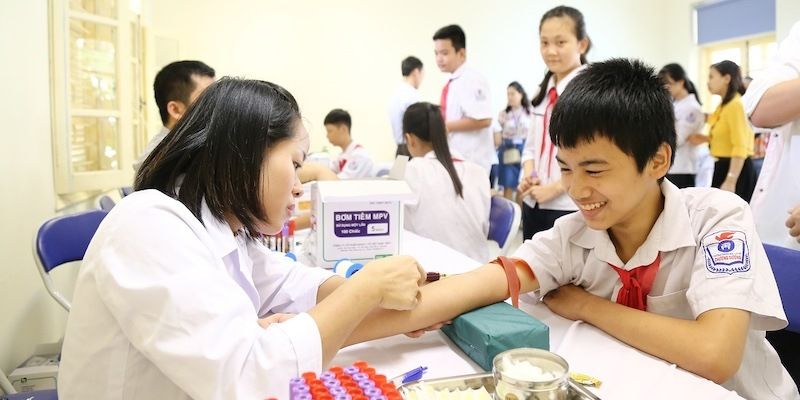
What Is the Health Belief Model? An Updated Look
Early detection through regular screening is key to preventing and treating many diseases. Despite this fact, participation in screening tends to be low. In Australia, [...]

Positive Pain Management: How to Better Manage Chronic Pain
Chronic pain is a condition that causes widespread, constant pain and distress and fills both sufferers and the healthcare professionals who treat them with dread. [...]
Read other articles by their category
- Body & Brain (49)
- Coaching & Application (58)
- Compassion (25)
- Counseling (51)
- Emotional Intelligence (23)
- Gratitude (18)
- Grief & Bereavement (21)
- Happiness & SWB (40)
- Meaning & Values (26)
- Meditation (20)
- Mindfulness (44)
- Motivation & Goals (45)
- Optimism & Mindset (34)
- Positive CBT (30)
- Positive Communication (21)
- Positive Education (47)
- Positive Emotions (32)
- Positive Leadership (19)
- Positive Parenting (15)
- Positive Psychology (34)
- Positive Workplace (37)
- Productivity (17)
- Relationships (43)
- Resilience & Coping (38)
- Self Awareness (21)
- Self Esteem (38)
- Strengths & Virtues (32)
- Stress & Burnout Prevention (34)
- Theory & Books (46)
- Therapy Exercises (37)
- Types of Therapy (64)
3 Positive Psychology Tools (PDF)
Want to create or adapt books like this? Learn more about how Pressbooks supports open publishing practices.
10.2 Piaget’s Concrete Operational and Formal Operational Stages
The Human Development Teaching & Learning Group
Learning Objectives
- Name three major advances in cognitive development that occur with the shift to concrete operational thinking.
- What do these developments allow that thinking during the preoperational stage did not?
- Provide some examples of how concrete operational thought is seen in children’s everyday functioning during middle childhood.
- What are the limitations of concrete operational thought?
- Describe Piaget’s formal operational stage and the characteristics of formal operational thought.
- Identify the advances and limitations of formal operational thought.
- Describe metacognition.
- Explore whether postformal thought exists.
Recall from the last section that during early childhood children are in Piaget’s preoperational stage , and during this stage, children are learning to think symbolically about the world. As children continue into elementary school, they develop the ability to represent ideas and events more flexibly and logically . Their rules of thinking still seem very basic by adult standards and usually operate unconsciously, but they allow children to solve problems more systematically than before, and therefore to be successful with many academic tasks.

Concrete Operational Thought
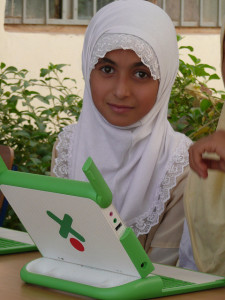
From ages 7 to 11, children are in what Piaget referred to as the concrete operational stage of cognitive development (Crain, 2005). This involves mastering the use of logic in concrete ways. The word concrete refers to that which is tangible; that which can be seen, touched, or experienced directly. Piaget called this period the concrete operational stage because children mentally “ operate ” on concrete objects and events. The concrete operational child is able to make use of logical principles in solving problems involving the physical world. For example, the child can understand principles of cause and effect, size, and distance. A child may unconsciously follow the rule: “If nothing is added or taken away, then the amount of something stays the same.” This simple principle helps children to understand certain arithmetic tasks, such as in adding or subtracting zero from a number, as well as to do certain classroom science experiments, such as ones involving judgments of the amounts of liquids when mixed.
The child can use logic to solve problems tied to their own direct experience, but has trouble solving hypothetical problems or considering more abstract problems. The child uses inductive reasoning, which is a logical process in which multiple premises believed to be true are combined to obtain a specific conclusion . For example, a child has one friend who is rude, another friend who is also rude, and the same is true for a third friend. The child may conclude that friends are rude. We will see that this way of thinking tends to change during adolescence as deductive reasoning emerges. We will now explore three of the major capacities that the concrete operational child exhibits.
Thought becomes multidimensional
Concrete operational children no longer focus on only one dimension of any object (such as the height of the glass) and instead can coordinate multiple dimensions simultaneously (such as the width of the glass). (That is, they are no longer limited by centration, which is why this gain is also known by the term “decentration”). Multidimensionality allows children to take multiple perspectives at the same time, to understand part-while relationships, and to cross classify objects using multiple features.

- Multiple perspectives. Recall that when young children in the preoperational stage were asked to describe the Three Mountain display from the perspective of someone sitting across the table form them, they could only report on the view form one perspective– their own. With the emergence of connote operations, children can now understand that people looking from different vantage points, see different features. They can coordinate multiple perspectives. This skill is very useful, and can be practiced, while playing with peers and settling peer disputes.
- Part-whole relationships. Think back to preoperational thought, where if you showing a long child a bouquet of six daisies and 3 roses, and asked them whether there were more daisies or flowers, they would typically answer”daisies”? They could not coordinate the two perspectives of “part” and “whole.” Now in middle childhood, these questions seem silly– of course there are more flowers, flowers include both daisies and roses. At the age, the correct answer is obvious– it’s a logical necessity.
- Classification. As children’s experiences and vocabularies grow, they build schemata and are able to organize objects in many different ways . They also understand classification hierarchies and can arrange objects into a variety of classes and subclasses.
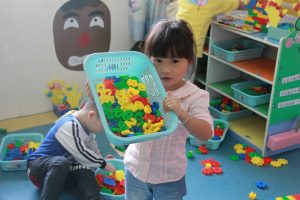
Thought becomes operational
A second major shift in cognitive development during middle childhood coccus when thought becomes operational , by which Piaget meant that it consists of reversible, organized systems of mental actions. These systems allow children to mentally undo actions ( reversibility ) and to understand that certain properties of objects (like their number, mass, volume, and so on) remain constant despite transformations in appearance ( conservation ).

- Reversibility. The child learns that some things that have been changed can be returned to their original state. Water can be frozen and then thawed to become liquid again, but eggs cannot be unscrambled. Arithmetic operations are reversible as well: 2 + 3 = 5 and 5 – 3 = 2. Many of these cognitive skills are incorporated into the school’s curriculum through mathematical problems and in worksheets about which situations are reversible or irreversible.
- Conservation. Remember the example in our last chapter of preoperational children thinking that a tall beaker filled with 8 ounces of water was “more” than a short, wide bowl filled with 8 ounces of water? Concrete operational children can understand the concept of conservation which means that changing one quality (in this example, height or water level) can be compensated for by changes in another quality (width). Consequently, there is the same amount of water in each container, although one is taller and narrower and the other is shorter and wider.
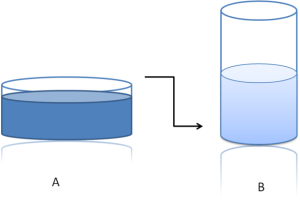
Thought becomes logical
A third major accomplishment of concrete operational development is that thought becomes logical , and children can reason logically about concrete events.
- Inferring higher-order characteristics. Where young children’s reasoning was focused on perceptual cues, older children can now consider a variety of specific cues and from, use the power of inference, to reach a logical conclusion about higher-order characteristics. This capacity is seen in children’s understanding of their own and other people’s capacities and personalities. For example, after a child does well on multiple multiple assignments in math, she may conclude that she is high in math ability.
- Identify defining features. Whereas young children’s understanding was dominated by the most perceptually salient features of objects, with concrete operational thought, children in middle childhood focus instead on the defining features of particular objects or states. They are not distracted by the most salient features; they recognize the underlying defining features. For example, young children might think that bicycles and toasters are alive (a kind of thought called “animism,” remember?) because they move. By middle childhood, however, children understand that even though many mechanical devices (e.g., cars, fireworks) and natural objects move (e.g., the sun, the tides), only plants and animals have a life force, which is the defining feature of being alive.

- Transitive inference. Being able to understand how objects are related to one another is referred to as transitivity, or transitive inference. This means that if one understands that a dog is a mammal, and that a poodle is a dog, then a poodle must be a mammal.
Limitations of concrete operational thought
These new cognitive skills increase the child’s understanding of the physical world, however according to Piaget, they still cannot think in abstract ways. Additionally, they do not think in systematic scientific ways. For example, when asked which variables influence the period that a pendulum takes to complete its arc and given weights they can attach to strings in order to do experiments, most children younger than 12 perform biased experiments from which no conclusions can be drawn (Inhelder & Piaget, 1958).
Formal Operational Thought
In the last of the Piagetian stages, the young adolescent becomes able to reason not only about tangible objects and events, but also about hypothetical or abstract ones. Hence, it has the name formal operational stage—the period when the individual can “operate” on “forms” or representations. This allows an individual to think and reason with a wider perspective. This stage of cognitive development, which Piaget called formal operational thought , marks a movement from an ability to think and reason from concrete visible events to an ability to think hypothetically and entertain what-if possibilities about the world. An individual can solve problems through abstract concepts and utilize hypothetical and deductive reasoning. Adolescents initially use trial and error to solve problems, but the ability to systematically solve a problem in a logical and methodical way emerges.
Hypothetical and Abstract Thinking
One of the major advances of formal operational thought is the capacity to think of possibility, not just reality. Adolescents’ thinking is less bound to concrete events than that of children; they can contemplate possibilities outside the realm of what currently exists. One manifestation of the adolescent’s increased facility with thinking about possibilities is the improvement of skill in deductive reasoning (also called top-down reasoning), which leads to the development of hypothetical thinking . This provides the ability to plan ahead, see the future consequences of an action and to provide alternative explanations of events. It also makes adolescents more skilled debaters, as they can reason against a friend’s or parent’s position. Adolescents also develop a more sophisticated understanding of probability.
This video explains some of the cognitive development consistent with formal operational thought.
You can view the transcript for “Formal operational stage – Intro to Psychology” here (opens in new window) .
Link to Learning: Formal Operational Thinking in the Classroom
School is a main contributor in guiding students towards formal operational thought. With students at this level, the teacher can pose hypothetical (or contrary-to-fact) problems: “What if the world had never discovered oil?” or “What if the first European explorers had settled first in California instead of on the East Coast of the United States?” To answer such questions, students must use hypothetical reasoning, meaning that they must manipulate ideas that vary in several ways at once, and do so entirely in their minds.
The hypothetical reasoning that concerned Piaget primarily involved scientific problems. His studies of formal operational thinking therefore often look like problems that middle or high school teachers pose in science classes. In one problem, for example, a young person is presented with a simple pendulum, onto which different amounts of weight can be hung (Inhelder & Piaget, 1958). The experimenter asks: “What determines how fast the pendulum swings: the length of the string holding it, the weight attached to it, or the distance that it is pulled to the side?” The young person is not allowed to solve this problem by trial-and-error with the materials themselves, but must reason a way to the solution mentally. To do so systematically, he or she must imagine varying each factor separately, while also imagining the other factors that are held constant. This kind of thinking requires facility at manipulating mental representations of the relevant objects and actions—precisely the skill that defines formal operations.
As you might suspect, students with an ability to think hypothetically have an advantage in many kinds of school work: by definition, they require relatively few “props” to solve problems. In this sense they can in principle be more self-directed than students who rely only on concrete operations—certainly a desirable quality in the opinion of most teachers. Note, though, that formal operational thinking is desirable but not sufficient for school success, and that it is far from being the only way that students achieve educational success. Formal thinking skills do not ensure that a student is motivated or well-behaved, for example, nor does it guarantee other desirable skills. The fourth stage in Piaget’s theory is really about a particular kind of formal thinking, the kind needed to solve scientific problems and devise scientific experiments. Since many people do not normally deal with such problems in the normal course of their lives, it should be no surprise that research finds that many people never achieve or use formal thinking fully or consistently, or that they use it only in selected areas with which they are very familiar (Case & Okomato, 1996). For teachers, the limitations of Piaget’s ideas suggest a need for additional theories about cognitive developments—ones that focus more directly on the social and interpersonal issues of childhood and adolescence.
Propositional thought
The appearance of more systematic, abstract thinking also allows adolescents to comprehend higher order abstract ideas, such as those inherent in puns, proverbs, metaphors, and analogies. Their increased facility permits them to appreciate the ways in which language can be used to convey multiple messages, such as satire, metaphor, and sarcasm. (Children younger than age nine often cannot comprehend sarcasm at all). This also permits the application of advanced reasoning and logical processes to social and ideological matters such as interpersonal relationships, politics, philosophy, religion, morality, friendship, faith, fairness, and honesty. This newfound ability also allows adolescents to take other’s perspectives in more complex ways, and to be able to better think through others’ points of view.
Metacognition
Meta-cognition refers to “thinking about thinking.” This often involves monitoring one’s own cognitive activity during the thinking process. Adolescents are more aware of their own thought processes and can use mnemonic devices and other strategies to think and remember information more efficiently. Metacognition provides the ability to plan ahead, consider the future consequences of an action, and provide alternative explanations of events.
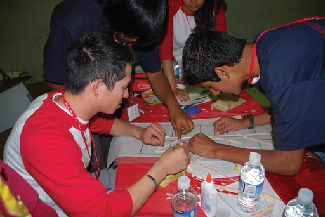
The capacity to consider multiple possibilities and perspectives often leads adolescents to the conclusion that nothing is absolute– everything appears to be relative. As a result, teens often start questioning everything that they had previously accepted– such as parent and family values, authority figures, religious practices, school rules, and political events. They may even start questioning things that took place when they were younger, like adoption or parental divorce. It is common for parents to feel that adolescents are just being argumentative, but this behavior signals a normal phase of cognitive development.
Beyond Formal Operational Thought: Post-formal Development?
According to Piagetian theory, formal operational thought emerges during adolescents. The hallmark of this type of thinking is the ability to think abstractly or to consider possibilities and ideas about circumstances not directly experienced. Thinking abstractly is only one characteristic of adult thought, however. If you compare a 15 year-old with someone in their late 30s, you would probably find that the latter considers not only what is possible, but also what is likely. Why the change? The adult has gained experience and understands that possibilities do not always become realities. They learn to base decisions on what is realistic and practical, not idealistic, and can make adaptive choices. Adults are also not as influenced by what others think.
In addition to moving toward more practical considerations, thinking in adulthood may also become more relativistic, dialectical, and systemic. These advanced ways of t hinking are referred to as Postformal Thought (Sinnott, 1998). Relativistic thinking refers to the appreciation of multiple perspectives, and the understanding that knowledge depends on the perspective of the knower . In later life, adults are able to continue to entertain multiple perspectives simultaneously, and also at the same time, in the face of all those possibilities, to make a decision, commit to a specific course of action, and carry it out. This suggests that such post-formal thought goes beyond cognition to the integration of thought and action.
Abstract ideas that the adolescent believes in firmly may become standards by which the adult evaluates reality. Adolescents tend to think in dichotomies ; ideas are true or false; good or bad; and there is no middle ground . However, with experience, the adult comes to recognize that there is some right and some wrong in each position, some good or some bad in a policy or approach, some truth and some falsity in a particular idea. This ability to appreciate essential paradox and to bring together salient aspects of two opposing viewpoints or positions is referred to as dialectical thought and is considered one of the most advanced aspects of postformal thinking (Basseches, 1984). Such thinking is more realistic because very few positions, ideas, situations, or people are completely right or wrong. So, for example, parents who were considered angels or devils by their adolescent children, to adult children, eventually become just people with strengths and weaknesses, endearing qualities, and faults.
Does everyone reach postformal or even formal operational thought?
Formal operational thought involves being able to think abstractly; however, this ability does not apply to all situations or all adults. Formal operational thought is influenced by experience and education. Some adults lead lives in which they are not challenged to think abstractly about their world. Many adults do not receive any formal education and are not taught to think abstractly about situations they have never experienced. Further, many people are not exposed to conceptual tools used to formally analyze hypothetical situations. Those who do think abstractly may be able to do so more easily in some subjects than others. For example, psychology majors may be able to think abstractly about psychology but be unable to use abstract reasoning in physics or chemistry. Abstract reasoning in a particular field requires a knowledge base that no one has in all areas. Consequently, our ability to think abstractly also depends on our experiences.
Basseches, M. (1984). Dialectical thinking and adult development . Ablex Pub.
Crain, W. (2005). Theories of development concepts and applications (5th ed.). Pearson
Inhelder, B., & Piaget, J. (1958). The growth of logical thinking from childhood to adolescence . Basic Books.
Sinnott, J. D. (1998). The development of logic in adulthood . Plenum Press.
- “Lifespan Development: A Psychological Perspective, Second Edition” by Martha Lally and Suzanne Valentine-French is licensed under a CC-BY-NC-SA-3.0
- “Educational Psychology ” by Kevin Seifert, OpenStax CNX , is licensed under a Creative Commons Attribution License 3.0 license / One sentence rephrased /Download for free at http://cnx.org/contents/[email protected].
- “Understanding the Whole Child: Prenatal Development Through Adolescence” by Jennifer Paris, Antoinette Ricardo, and Dawn Rymond , College of the Canyons is licensed under CC BY 4.0 / A derivative from the original work
- Cognitive Development in Childhood by Boundless is licensed under CC BY-SA 4.0
- “Cognitvie Development During Middle Childhood” by Lumen Learning is Licensed under CC BY 4.0 .
- “Puberty & Cognition” by Ellen Skinner, Dan Grimes, & Brandy Brennan, Portland State University is licensed under a CC-BY-NC-SA-4.0
- Lifespan Development by Lumen Learning is licensed under a Creative Commons Attribution 4.0 International License /modified and adapted by Ellen Skinner & Dan Grimes, Portland State University
Media Attributions
- Iraqi girl with computer. Authored by : Education in Iraq. Located at : https://www.flickr.com/photos/olpc/2933585330/in/gallery-101408425@N06-72157644977579723/ . License : CC BY: Attribution
- 640px-Conservation2 © Waterlily16 is licensed under a CC BY-SA (Attribution ShareAlike) license
- snowflake_puzzle_nursery_play_toys-1365697.jpg!d is licensed under a CC0 (Creative Commons Zero) license
- Conservation_of_Liquid © Ydolem2689 is licensed under a CC BY-SA (Attribution ShareAlike) license
- 23746727113_8d110feafd_w © John Liu is licensed under a CC BY (Attribution) license
- 556px-Seriation_task_w_shapes © MehreenH is licensed under a CC BY-SA (Attribution ShareAlike) license
- ezequiel-garrido-Gj7mfnSqzvE-unsplash © Ezequiel Garrido is licensed under a CC0 (Creative Commons Zero) license
- adolescent boys. Authored by : An Min. Provided by : Pxhere. Located at : https://pxhere.com/en/photo/1515959 . License : CC0: No Rights Reserved
All Rights Reserved Content
- Formal operational stage – Intro to Psychology. Provided by : Udacity. Located at : https://www.youtube.com/watch?v=hvq7tq2fx1Y . License : Other . License Terms : Standard YouTube License
10.2 Piaget's Concrete Operational and Formal Operational Stages Copyright © by The Human Development Teaching & Learning Group is licensed under a Creative Commons Attribution-NonCommercial-ShareAlike 4.0 International License , except where otherwise noted.
Share This Book

- school Campus Bookshelves
- menu_book Bookshelves
- perm_media Learning Objects
- login Login
- how_to_reg Request Instructor Account
- hub Instructor Commons
Margin Size
- Download Page (PDF)
- Download Full Book (PDF)
- Periodic Table
- Physics Constants
- Scientific Calculator
- Reference & Cite
- Tools expand_more
- Readability
selected template will load here
This action is not available.

10.4: Piaget formal operational stage
- Last updated
- Save as PDF
- Page ID 180268
\( \newcommand{\vecs}[1]{\overset { \scriptstyle \rightharpoonup} {\mathbf{#1}} } \)
\( \newcommand{\vecd}[1]{\overset{-\!-\!\rightharpoonup}{\vphantom{a}\smash {#1}}} \)
\( \newcommand{\id}{\mathrm{id}}\) \( \newcommand{\Span}{\mathrm{span}}\)
( \newcommand{\kernel}{\mathrm{null}\,}\) \( \newcommand{\range}{\mathrm{range}\,}\)
\( \newcommand{\RealPart}{\mathrm{Re}}\) \( \newcommand{\ImaginaryPart}{\mathrm{Im}}\)
\( \newcommand{\Argument}{\mathrm{Arg}}\) \( \newcommand{\norm}[1]{\| #1 \|}\)
\( \newcommand{\inner}[2]{\langle #1, #2 \rangle}\)
\( \newcommand{\Span}{\mathrm{span}}\)
\( \newcommand{\id}{\mathrm{id}}\)
\( \newcommand{\kernel}{\mathrm{null}\,}\)
\( \newcommand{\range}{\mathrm{range}\,}\)
\( \newcommand{\RealPart}{\mathrm{Re}}\)
\( \newcommand{\ImaginaryPart}{\mathrm{Im}}\)
\( \newcommand{\Argument}{\mathrm{Arg}}\)
\( \newcommand{\norm}[1]{\| #1 \|}\)
\( \newcommand{\Span}{\mathrm{span}}\) \( \newcommand{\AA}{\unicode[.8,0]{x212B}}\)
\( \newcommand{\vectorA}[1]{\vec{#1}} % arrow\)
\( \newcommand{\vectorAt}[1]{\vec{\text{#1}}} % arrow\)
\( \newcommand{\vectorB}[1]{\overset { \scriptstyle \rightharpoonup} {\mathbf{#1}} } \)
\( \newcommand{\vectorC}[1]{\textbf{#1}} \)
\( \newcommand{\vectorD}[1]{\overrightarrow{#1}} \)
\( \newcommand{\vectorDt}[1]{\overrightarrow{\text{#1}}} \)
\( \newcommand{\vectE}[1]{\overset{-\!-\!\rightharpoonup}{\vphantom{a}\smash{\mathbf {#1}}}} \)
During the formal operational stage, adolescents are able to understand abstract principles . They are no longer limited by what can be directly seen or heard, and are able to contemplate such constructs as beauty, love, freedom, and morality. Additionally, while younger children solve problems through trial and error, adolescents demonstrate hypothetical-deductive reasoning , which is developing hypotheses based on what might logically occur. They are able to think about all the possibilities in a situation beforehand, and then test them systematically, (Crain, 2005) because they are able to engage in true scientific thinking.
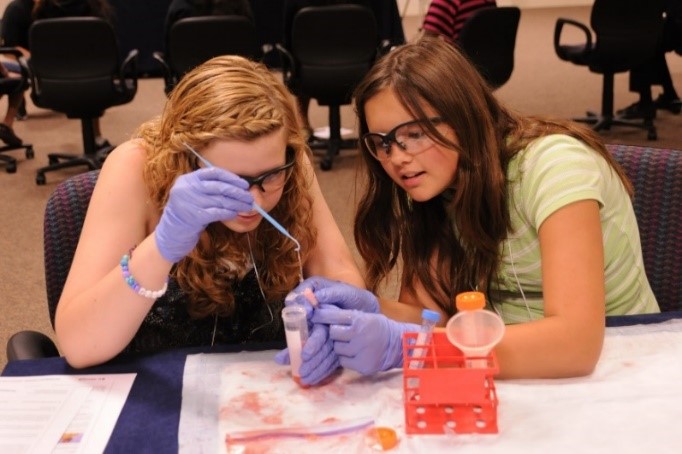
Does everyone reach formal operations?
According to Piaget, most people attain some degree of formal operational thinking, but use formal operations primarily in the areas of their strongest interest (Crain, 2005). In fact, most adults do not regularly demonstrate formal operational thought. A possible explanation is that an individual’s thinking has not been sufficiently challenged to demonstrate formal operational thought in all areas.
Adolescent Egocentrism
Once adolescents can understand abstract thoughts, they enter a world of hypothetical possibilities and demonstrate egocentrism, a heightened self-focus. The egocentricity comes from attributing unlimited power to their own thoughts (Crain, 2005). Piaget believed it was not until adolescents took on adult roles that they would be able to learn the limits to their own thoughts.
David Elkind: On Piaget’s Theory
David Elkind (1967) expanded on the concept of Piaget’s adolescent egocentricity. Elkind theorized that the physiological changes that occur during adolescence result in adolescents being primarily concerned with themselves. Additionally, since adolescents fail to differentiate between what others are thinking and their own thoughts, they believe that others are just as fascinated with their behavior and appearance. This belief results in the adolescent anticipating the reactions of others, and consequently constructing an imaginary audience. The imaginary audience is the adolescent’s belief that those around them are as concerned and focused on their appearance as they themselves are (Schwartz, Maynard, & Uzelac, 2008, p. 441). Elkind thought that the imaginary audience contributed to the self-consciousness that occurs during early adolescence. The desire for privacy and the reluctance to share personal information may be a further reaction to feeling under constant observation by others.
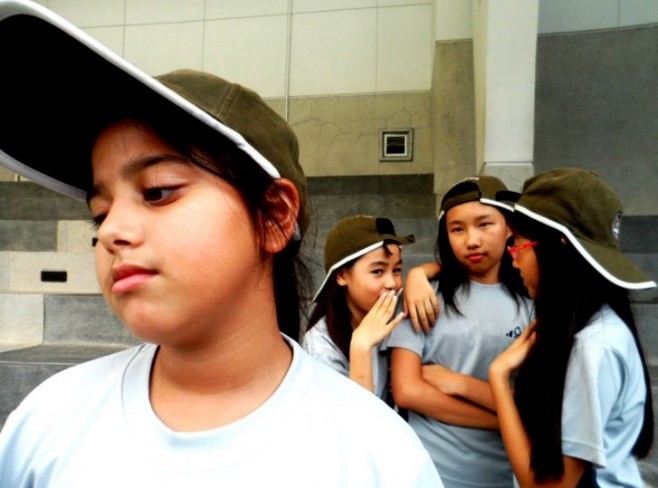
Another important consequence of adolescent egocentrism is the personal fable or belief that one is unique, special, and invulnerable to harm. Elkind (1967) explains that because adolescents feel so important to others (imaginary audience) they regard themselves and their feelings as being special and unique. Adolescents believe that only they have experienced strong and diverse emotions, and therefore others could never understand how they feel. This uniqueness in one’s emotional experiences reinforces the adolescent’s belief of invulnerability, especially to death. Adolescents will engage in risky behaviors, such as drinking and driving or unprotected sex, and feel they will not suffer any negative consequences. Elkind believed that adolescent egocentricity emerged in early adolescence and declined in middle adolescence, however, recent research has also identified egocentricity in late adolescence (Schwartz, et al., 2008).
Consequences of Formal Operational Thought
As adolescents are now able to think abstractly and hypothetically, they exhibit many new ways of reflecting on information (Dolgin, 2011). For example, they demonstrate greater introspection or thinking about one’s thoughts and feelings. They begin to imagine how the world could be, which leads them to become idealistic or insisting upon high standards of behavior. Because of their idealism, they may become critical of others, especially adults in their life. Additionally, adolescents can demonstrate hypocrisy , or pretend to be what they are not. Since they are able to recognize what others expect of them, they will conform to those expectations for their emotions and behavior seemingly hypocritical to themselves. Lastly, adolescents can exhibit pseudostupidity, which is when they approach problems at a level that is too complex and they fail because the tasks are too simple. Their new ability to consider alternatives is not completely under control and they appear “stupid” when they are in fact bright, just inexperienced. [4]
Attributions:
Child Growth and Development by Jennifer Paris, Antoinette Ricardo, and Dawn Rymond, 2019, is licensed under CC BY 4.0
[1] Image by the U.S. Army CCDC is licensed under CC BY 2.0
[2] Image by Ian Joslin is licensed under CC BY 4.0 .
[3] Image by Twentyfour Students is licensed under CC BY-SA 2.0
[4] Lifespan Development: A Psychological Perspective by Martha Lally and Suzanne Valentine-French is licensed under CC BY-NC-SA 3.0
- Type 2 Diabetes
- Heart Disease
- Digestive Health
- Multiple Sclerosis
- Diet & Nutrition
- Supplements
- Health Insurance
- Public Health
- Patient Rights
- Caregivers & Loved Ones
- End of Life Concerns
- Health News
- Thyroid Test Analyzer
- Doctor Discussion Guides
- Hemoglobin A1c Test Analyzer
- Lipid Test Analyzer
- Complete Blood Count (CBC) Analyzer
- What to Buy
- Editorial Process
- Meet Our Medical Expert Board
Cognitive Development Theory: What Are the Stages?
Sensorimotor stage, preoperational stage, concrete operational stage, formal operational stage.
Cognitive development is the process by which we come to acquire, understand, organize, and learn to use information in various ways. Cognitive development helps a child obtain the skills needed to live a productive life and function as an independent adult.
The late Swiss psychologist Jean Piaget was a major figure in the study of cognitive development theory in children. He believed that it occurs in four stages—sensorimotor, preoperational, concrete operational, and formal operational.
This article discusses Piaget’s stages of cognitive development, including important concepts and principles.
FatCamera / Getty Images
History of Cognitive Development
During the 1920s, the psychologist Jean Piaget was given the task of translating English intelligence tests into French. During this process, he observed that children think differently than adults do and have a different view of the world. He began to study children from birth through the teenage years—observing children who were too young to talk, and interviewing older children while he also observed their development.
Piaget published his theory of cognitive development in 1936. This theory is based on the idea that a child’s intelligence changes throughout childhood and cognitive skills—including memory, attention, thinking, problem-solving, logical reasoning, reading, listening, and more—are learned as a child grows and interacts with their environment.
Stages of Cognitive Development
Piaget’s theory suggests that cognitive development occurs in four stages as a child ages. These stages are always completed in order, but last longer for some children than others. Each stage builds on the skills learned in the previous stage.
The four stages of cognitive development include:
- Sensorimotor
- Preoperational
- Concrete operational
- Formal operational
The sensorimotor stage begins at birth and lasts until 18 to 24 months of age. During the sensorimotor stage, children are physically exploring their environment and absorbing information through their senses of smell, sight, touch, taste, and sound.
The most important skill gained in the sensorimotor stage is object permanence, which means that the child knows that an object still exists even when they can't see it anymore. For example, if a toy is covered up by a blanket, the child will know the toy is still there and will look for it. Without this skill, the child thinks that the toy has simply disappeared.
Language skills also begin to develop during the sensorimotor stage.
Activities to Try During the Sensorimotor Stage
Appropriate activities to do during the sensorimotor stage include:
- Playing peek-a-boo
- Reading books
- Providing toys with a variety of textures
- Singing songs
- Playing with musical instruments
- Rolling a ball back and forth
The preoperational stage of Piaget's theory of cognitive development occurs between ages 2 and 7 years. Early on in this stage, children learn the skill of symbolic representation. This means that an object or word can stand for something else. For example, a child might play "house" with a cardboard box.
At this stage, children assume that other people see the world and experience emotions the same way they do, and their main focus is on themselves. This is called egocentrism .
Centrism is another characteristic of the preoperational stage. This means that a child is only able to focus on one aspect of a problem or situation. For example, a child might become upset that a friend has more pieces of candy than they do, even if their pieces are bigger.
During this stage, children will often play next to each other—called parallel play—but not with each other. They also believe that inanimate objects, such as toys, have human lives and feelings.
Activities to Try During the Preoperational Stage
Appropriate activities to do during the preoperational stage include:
- Playing "house" or "school"
- Building a fort
- Playing with Play-Doh
- Building with blocks
- Playing charades
The concrete operational stage occurs between the ages of 7 and 11 years. During this stage, a child develops the ability to think logically and problem-solve but can only apply these skills to objects they can physically see—things that are "concrete."
Six main concrete operations develop in this stage. These include:
- Conservation : This skill means that a child understands that the amount of something or the number of a particular object stays the same, even when it looks different. For example, a cup of milk in a tall glass looks different than the same amount of milk in a short glass—but the amount did not change.
- Classification : This skill is the ability to sort items by specific classes, such as color, shape, or size.
- Seriation : This skill involves arranging objects in a series, or a logical order. For example, the child could arrange blocks in order from smallest to largest.
- Reversibility : This skill is the understanding that a process can be reversed. For example, a balloon can be blown up with air and then deflated back to the way it started.
- Decentering : This skill allows a child to focus on more than one aspect of a problem or situation at the same time. For example, two candy bars might look the same on the outside, but the child knows that they have different flavors on the inside.
- Transitivity : This skill provides an understanding of how things relate to each other. For example, if John is older than Susan, and Susan is older than Joey, then John is older than Joey.
Activities to Try During the Concrete Operational Stage
Appropriate activities to do during the concrete operational stage include:
- Using measuring cups (for example, demonstrate how one cup of water fills two half-cups)
- Solving simple logic problems
- Practicing basic math
- Doing crossword puzzles
- Playing board games
The last stage in Piaget's theory of cognitive development occurs during the teenage years into adulthood. During this stage, a person learns abstract thinking and hypothetical problem-solving skills.
Deductive reasoning—or the ability to make a conclusion based on information gained from a person's environment—is also learned in this stage. This means, for example, that a person can identify the differences between dogs of various breeds, instead of putting them all in a general category of "dogs."
Activities to Try During the Formal Operational Stage
Appropriate activities to do during the formal operational stage include:
- Learning to cook
- Solving crossword and logic puzzles
- Exploring hobbies
- Playing a musical instrument
Piaget's theory of cognitive development is based on the belief that a child gains thinking skills in four stages: sensorimotor, preoperational, concrete operational, and formal operational. These stages roughly correspond to specific ages, from birth to adulthood. Children progress through these stages at different paces, but according to Piaget, they are always completed in order.
National Library of Medicine. Cognitive testing . MedlinePlus.
Oklahoma State University. Cognitive development: The theory of Jean Piaget .
SUNY Cortland. Sensorimotor stage .
Marwaha S, Goswami M, Vashist B. Prevalence of principles of Piaget’s theory among 4-7-year-old children and their correlation with IQ . J Clin Diagn Res. 2017;11(8):ZC111-ZC115. doi:10.7860%2FJCDR%2F2017%2F28435.10513
Börnert-Ringleb M, Wilbert J. The association of strategy use and concrete-operational thinking in primary school . Front Educ. 2018;0. doi:10.3389/feduc.2018.00038
By Aubrey Bailey, PT, DPT, CHT Dr, Bailey is a Virginia-based physical therapist and professor of anatomy and physiology with over a decade of experience.
- WordPress.org
- Documentation
- Learn WordPress
- Members Newsfeed
Piaget’s Theory of Cognitive Development: The Formal Operational Stage
- Uncategorized
In his theory of cognitive development , Jean Piaget stated that there are four stages that each individual goes through . The fourth and last stage of cognitive development is called the Formal Operational Stage. This period takes place at around 12 years old and lasts well into adulthood.
What Happens During the Formal Operational Stage?
This is the time when thinking skills become advanced and more sophisticated. Those in this stage can think about abstract and theoretical concepts and can use logic to come up with solutions to problems.
Skills such as logical thought, deductive reasoning, and systematic planning are developed during this time.
Developing the Idea: Piaget’s Research
Jean Piaget conducted tests to support his theory of cognitive development. For the Formal Operational Stage, he came up with two: (1) physical conceptualization and (2) abstraction of thought.
For physical conceptualization, he used the concept of balance. Children from different age groups were asked to balance a scale. He found that those in the Formal Operational Stage (approximately 13 years old) made a hypothesis about where to place the weights to achieve balance. 10-year-old subjects used the trial-and-error method, while 7-year-olds placed weights on each side of the scale but did not consider the placement of the weights. Subjects younger than 7 years old were not able to complete the task because they did not understand the concept of balance.
In the second test, which had to do with the abstraction of thought, children were asked to think of where to put a third eye if they could have one. Most of the younger children stated that they wanted to place the third eye in the middle of the forehead, while those in the Formal Operational Stage suggested more creative answers like putting it behind the head to see what’s happening behind them.
Creative ideas such as the answers provided by the children in the Formal Operational Stage are indicative of the use of abstract and hypothetical thought.
Notable Skills
The skills listed below are indicators of the Formal Operational Stage of Cognitive Development:
1. Deductive Logic – this has to do with being able to think in broader terms. Children at this stage can come up with solutions to problems using logic and general principles. This skill is useful in Science and Math.
2. Abstract Thought – has to do with being able to think about abstract ideas. They consider possible outcomes, which include out-of-the-box ideas to solve problems. This skill is useful for long term planning.
3. Problem Solving – is the ability to plan an efficient and logical approach to solve a problem.
4. Hypothetical-Deductive Reasoning – children at this age think about what-ifs and attempt to formulate various solutions to solve them.
The Formal Operational Stage is the last of four stages of cognitive development posited by Jean Piaget. Formal operational thinkers can think of different solutions to solve a problem, including those that are creative and abstract. Individuals in this stage think carefully before they act.
Related Articles

Ensuring that students are well-rounded and knowledgeable about various aspects of society…

Father’s Day is celebrated to appreciate and honor the affection, love, and…
Juneteenth is a day that commemorates the end of slavery in America.…

Pedagogue is a social media network where educators can learn and grow. It's a safe space where they can share advice, strategies, tools, hacks, resources, etc., and work together to improve their teaching skills and the academic performance of the students in their charge.
If you want to collaborate with educators from around the globe, facilitate remote learning, etc., sign up for a free account today and start making connections.
Pedagogue is Free Now, and Free Forever!
- New? Start Here
- Frequently Asked Questions
- Privacy Policy
- Terms of Service
- Registration
Don't you have an account? Register Now! it's really simple and you can start enjoying all the benefits!
We just sent you an Email. Please Open it up to activate your account.
I allow this website to collect and store submitted data.
Chapter 6: Adolescence
Piaget’s formal operational stage of cognitive development.
During the formal operational stage, adolescents are able to understand abstract principles which have no physical reference. They can now contemplate such abstract constructs as beauty, love, freedom, and morality. The adolescent is no longer limited by what can be directly seen or heard. Additionally, while younger children solve problems through trial and error, adolescents demonstrate hypothetical-deductive reasoning , which is developing hypotheses based on what might logically occur . They are able to think about all the possibilities in a situation beforehand, and then test them systematically (Crain, 2005). Now they are able to engage in true scientific thinking. Formal operational thinking also involves accepting hypothetical situations. Adolescents understand the concept of transitivity , which means that a relationship between two elements is carried over to other elements logically related to the first two , such as if A<B and B<C, then A<C (Thomas, 1979). For example, when asked: If Maria is shorter than Alicia and Alicia is shorter than Caitlyn, who is the shortest? Adolescents are able to answer the question correctly as they understand the transitivity involved.
Does everyone reach formal operations? According to Piaget, most people attain some degree of formal operational thinking, but use formal operations primarily in the areas of their strongest interest (Crain, 2005). In fact, most adults do not regularly demonstrate formal operational thought, and in small villages and tribal communities, it is barely used at all. A possible explanation is that an individual’s thinking has not been sufficiently challenged to demonstrate formal operational thought in all areas.
Adolescent Egocentrism: Once adolescents can understand abstract thoughts, they enter a world of hypothetical possibilities and demonstrate egocentrism or a heightened self-focus . The egocentricity comes from attributing unlimited power to their own thoughts (Crain, 2005). Piaget believed it was not until adolescents took on adult roles that they would be able to learn the limits to their own thoughts.
David Elkind (1967) expanded on the concept of Piaget’s adolescent egocentricity. Elkind theorized that the physiological changes that occur during adolescence result in adolescents being primarily concerned with themselves. Additionally, since adolescents fail to differentiate between what others are thinking and their own thoughts, they believe that others are just as fascinated with their behavior and appearance. This belief results in the adolescent anticipating the reactions of others, and consequently constructing an imaginary audience. “The imaginary audience is the adolescent’s belief that those around them are as concerned and focused on their appearance as they themselves are” (Schwartz, Maynard, & Uzelac, 2008, p. 441). Elkind thought that the imaginary audience contributed to the self-consciousness that occurs during early adolescence. The desire for privacy and reluctance to share personal information may be a further reaction to feeling under constant observation by others.
Another important consequence of adolescent egocentrism is the personal fable or belief that one is unique, special, and invulnerable to harm. Elkind (1967) explains that because adolescents feel so important to others (imaginary audience) they regard themselves and their feelings as being special and unique. Adolescents believe that only they have experienced strong and diverse emotions, and therefore others could never understand how they feel. This uniqueness in one’s emotional experiences reinforces the adolescent’s belief of invulnerability, especially to death. Adolescents will engage in risky behaviors, such as drinking and driving or unprotected sex, and feel they will not suffer any negative consequences. Elkind believed that adolescent egocentricity emerged in early adolescence and declined in middle adolescence, however, recent research has also identified egocentricity in late adolescence (Schwartz, et al., 2008).
Consequences of Formal Operational Thought: As adolescents are now able to think abstractly and hypothetically, they exhibit many new ways of reflecting on information (Dolgin, 2011). For example, they demonstrate greater introspection or thinking about one’s thoughts and feelings . They begin to imagine how the world could be which leads them to become idealistic or insisting upon high standards of behavior. Because of their idealism, they may become critical of others, especially adults in their life. Additionally, adolescents can demonstrate hypocrisy , or pretend to be what they are not. Since they are able to recognize what others expect of them, they will conform to those expectations for their emotions and behavior seemingly hypocritical to themselves. Lastly, adolescents can exhibit pseudostupidity. This is when they approach problems at a level that is too complex and they fail because the tasks are too simple. Their new ability to consider alternatives is not completely under control and they appear “stupid” when they are in fact bright, just not experienced.
Learning Objectives: Cognitive Development in Adolescence
- Describe Piaget’s formal operational stage and the characteristics of formal operational thought
- Describe adolescent egocentrism
- Describe Information Processing research on attention and memory
- Describe the developmental changes in language
- Describe the various types of adolescent education
- Identify changes in high school drop-out rates based on gender and ethnicity
- Authored by : Martha Lally and Suzanne Valentine-French. Provided by : College of Lake County Foundation. Located at : http://dept.clcillinois.edu/psy/LifespanDevelopment.pdf . License : CC BY-NC-SA: Attribution-NonCommercial-ShareAlike

Privacy Policy
- Bipolar Disorder
- Therapy Center
- When To See a Therapist
- Types of Therapy
- Best Online Therapy
- Best Couples Therapy
- Best Family Therapy
- Managing Stress
- Sleep and Dreaming
- Understanding Emotions
- Self-Improvement
- Healthy Relationships
- Student Resources
- Personality Types
- Guided Meditations
- Verywell Mind Insights
- 2024 Verywell Mind 25
- Mental Health in the Classroom
- Editorial Process
- Meet Our Review Board
- Crisis Support
- Piaget's Theory
- Sensorimotor Stage
- Preoperational Stage
- Concrete Operational Stage
- Formal Operational Stage
- Support and Criticism
Piaget's 4 Stages of Cognitive Development Explained
Background and Key Concepts of Piaget's Theory
Kendra Cherry, MS, is a psychosocial rehabilitation specialist, psychology educator, and author of the "Everything Psychology Book."
:max_bytes(150000):strip_icc():format(webp)/IMG_9791-89504ab694d54b66bbd72cb84ffb860e.jpg)
Important Cognitive Development Concepts
Take the pop quiz.
- Next in Stages of Cognitive Development Guide The Sensorimotor Stage of Cognitive Development
Jean Piaget's theory of cognitive development suggests that children move through four different stages of learning. His theory focuses not only on understanding how children acquire knowledge, but also on understanding the nature of intelligence. Piaget's stages are:
- Sensorimotor stage : Birth to 2 years
- Preoperational stage : Ages 2 to 7
- Concrete operational stage : Ages 7 to 11
- Formal operational stage : Ages 12 and up
Piaget believed that children take an active role in the learning process, acting much like little scientists as they perform experiments, make observations, and learn about the world. As kids interact with the world around them, they continually add new knowledge, build upon existing knowledge, and adapt previously held ideas to accommodate new information.
Test Your Knowledge
At the end of this article, take a fast and free pop quiz to see how much you know about Jean Piaget's work.
History of Piaget's Theory of Cognitive Development
Piaget was born in Switzerland in the late 1800s and was a precocious student, publishing his first scientific paper when he was just 11 years old. His early exposure to the intellectual development of children came when he worked as an assistant to Alfred Binet and Theodore Simon as they worked to standardize their famous IQ test .
Piaget vs. Vygotsky
Piaget's theory differs in important ways from those of Lev Vygotsky , another influential figure in the field of child development. Vygotsky acknowledged the roles that curiosity and active involvement play in learning, but placed greater emphasis on society and culture.
Piaget felt that development is largely fueled from within, while Vygotsky believed that external factors (such as culture) and people (such as parents, caregivers, and peers) play a more significant role.
Much of Piaget's interest in the cognitive development of children was inspired by his observations of his own nephew and daughter. These observations reinforced his budding hypothesis that children's minds were not merely smaller versions of adult minds.
Until this point in history, children were largely treated simply as smaller versions of adults. Piaget was one of the first to identify that the way that children think is different from the way adults think.
Piaget proposed that intelligence grows and develops through a series of stages. Older children do not just think more quickly than younger children. Instead, there are both qualitative and quantitative differences between the thinking of young children versus older children.
Based on his observations, he concluded that children were not less intelligent than adults—they simply think differently. Albert Einstein called Piaget's discovery "so simple only a genius could have thought of it."
Piaget's stage theory describes the cognitive development of children . Cognitive development involves changes in cognitive process and abilities. In Piaget's view, early cognitive development involves processes based upon actions and later progresses to changes in mental operations.
The Sensorimotor Stage of Cognitive Development
During this earliest stage of cognitive development, infants and toddlers acquire knowledge through sensory experiences and manipulating objects. A child's entire experience at the earliest period of this stage occurs through basic reflexes, senses, and motor responses.
Birth to 2 Years
Major characteristics and developmental changes during this stage:
- Know the world through movements and sensations
- Learn about the world through basic actions such as sucking, grasping, looking, and listening
- Learn that things continue to exist even when they cannot be seen ( object permanence )
- Realize that they are separate beings from the people and objects around them
- Realize that their actions can cause things to happen in the world around them
During the sensorimotor stage, children go through a period of dramatic growth and learning. As kids interact with their environment, they continually make new discoveries about how the world works.
The cognitive development that occurs during this period takes place over a relatively short time and involves a great deal of growth. Children not only learn how to perform physical actions such as crawling and walking; they also learn a great deal about language from the people with whom they interact. Piaget also broke this stage down into substages. Early representational thought emerges during the final part of the sensorimotor stage.
Piaget believed that developing object permanence or object constancy, the understanding that objects continue to exist even when they cannot be seen, was an important element at this point of development.
By learning that objects are separate and distinct entities and that they have an existence of their own outside of individual perception, children are then able to begin to attach names and words to objects.
The Preoperational Stage of Cognitive Development
The foundations of language development may have been laid during the previous stage, but the emergence of language is one of the major hallmarks of the preoperational stage of development.
2 to 7 Years
- Begin to think symbolically and learn to use words and pictures to represent objects
- Tend to be egocentric and struggle to see things from the perspective of others
- Getting better with language and thinking, but still tend to think in very concrete terms
At this stage, kids learn through pretend play but still struggle with logic and taking the point of view of other people. They also often struggle with understanding the idea of constancy.
Children become much more skilled at pretend play during this stage of development, yet they continue to think very concretely about the world around them.
For example, a researcher might take a lump of clay, divide it into two equal pieces, and then give a child the choice between two pieces of clay to play with. One piece of clay is rolled into a compact ball while the other is smashed into a flat pancake shape. Because the flat shape looks larger, the preoperational child will likely choose that piece, even though the two pieces are exactly the same size.
The Concrete Operational Stage of Cognitive Development
While children are still very concrete and literal in their thinking at this point in development, they become much more adept at using logic. The egocentrism of the previous stage begins to disappear as kids become better at thinking about how other people might view a situation.
7 to 11 Years
- Begin to think logically about concrete events
- Begin to understand the concept of conservation; that the amount of liquid in a short, wide cup is equal to that in a tall, skinny glass, for example
- Thinking becomes more logical and organized, but still very concrete
- Begin using inductive logic, or reasoning from specific information to a general principle
While thinking becomes much more logical during the concrete operational state, it can also be very rigid. Kids at this point in development tend to struggle with abstract and hypothetical concepts.
During this stage, children also become less egocentric and begin to think about how other people might think and feel. Kids in the concrete operational stage also begin to understand that their thoughts are unique to them and that not everyone else necessarily shares their thoughts, feelings, and opinions.
The Formal Operational Stage of Cognitive Development
The final stage of Piaget's theory involves an increase in logic, the ability to use deductive reasoning, and an understanding of abstract ideas. At this point, adolescents and young adults become capable of seeing multiple potential solutions to problems and think more scientifically about the world around them.
Age 12 and Up
Major characteristics and developmental changes during this time:
- Begins to think abstractly and reason about hypothetical problems
- Begins to think more about moral, philosophical, ethical, social, and political issues that require theoretical and abstract reasoning
- Begins to use deductive logic, or reasoning from a general principle to specific information
The ability to thinking about abstract ideas and situations is the key hallmark of the formal operational stage of cognitive development. The ability to systematically plan for the future and reason about hypothetical situations are also critical abilities that emerge during this stage.
It is important to note that Piaget did not view children's intellectual development as a quantitative process. That is, kids do not just add more information and knowledge to their existing knowledge as they get older.
Instead, Piaget suggested that there is a qualitative change in how children think as they gradually process through these four stages. At age 7, children don't just have more information about the world than they did at age 2; there is a fundamental change in how they think about the world.
Piaget suggested several factors that influence how children learn and grow.
A schema describes both the mental and physical actions involved in understanding and knowing. Schemas are categories of knowledge that help us to interpret and understand the world.
In Piaget's view, a schema includes both a category of knowledge and the process of obtaining that knowledge. As experiences happen, this new information is used to modify, add to, or change previously existing schemas.
For example, a child may have a schema about a type of animal, such as a dog. If the child's sole experience has been with small dogs, a child might believe that all dogs are small, furry, and have four legs. Suppose then that the child encounters an enormous dog. The child will take in this new information, modifying the previously existing schema to include these new observations.
Assimilation
The process of taking in new information into our already existing schemas is known as assimilation. The process is somewhat subjective because we tend to modify experiences and information slightly to fit in with our preexisting beliefs. In the example above, seeing a dog and labeling it "dog" is a case of assimilating the animal into the child's dog schema.
Accommodation
Another part of adaptation is the ability to change existing schemas in light of new information; this process is known as accommodation. New schemas may also be developed during this process.
Equilibration
As children progress through the stages of cognitive development, it is important to maintain a balance between applying previous knowledge (assimilation) and changing behavior to account for new knowledge (accommodation).
Piaget believed that all children try to strike a balance between assimilation and accommodation using a mechanism he called equilibration. Equilibration helps explain how children can move from one stage of thought to the next.
One of the main points of Piaget's theory is that creating knowledge and intelligence is an inherently active process.
"I find myself opposed to the view of knowledge as a passive copy of reality," Piaget wrote. "I believe that knowing an object means acting upon it, constructing systems of transformations that can be carried out on or with this object. Knowing reality means constructing systems of transformations that correspond, more or less adequately, to reality."
Piaget's theory of cognitive development helped add to our understanding of children's intellectual growth. It also stressed that children were not merely passive recipients of knowledge. Instead, kids are constantly investigating and experimenting as they build their understanding of how the world works.
Hugar SM, Kukreja P, Assudani HG, Gokhale N. Evaluation of the relevance of Piaget's cognitive principles among parented and orphan children in Belagavi City, Karnataka, India: A comparative study . I nt J Clin Pediatr Dent. 2017;10(4):346-350. doi:10.5005/jp-journals-10005-1463
Malik F. Cognitive development . In: StatPearls [Internet]. StatPearls Publishing.
Scott HK. Piaget . In: StatPearls [Internet]. StatPearls Publishing.
Fischer KW, Bullock D. Cognitive development in school-age children: Conclusions and new directions . In: Development During Middle Childhood: The Years From Six to Twelve. National Academies Press.
Sobel AA, Resick PA, Rabalais AE. The effect of cognitive processing therapy on cognitions: impact statement coding . J Trauma Stress. 2009;22(3):205-11. doi:10.1002/jts.20408
Piaget J. The Essential Piaget. Gruber HE, Voneche JJ. eds. Basic Books.
Fancher RE, Rutherford A. Pioneers of Psychology: A History . W.W. Norton.
Santrock JW. A Topical Approach to Lifespan Development (8th ed.) . McGraw-Hill.
By Kendra Cherry, MSEd Kendra Cherry, MS, is a psychosocial rehabilitation specialist, psychology educator, and author of the "Everything Psychology Book."

Piaget’s Formal Operational Stage of Cognitive Development
In Piaget’s formal operational stage, which begins at around the age of 11 and continues until later teenage years, children undergo a crucial mental transformation. They acquire the ability to think abstractly and hypothetically , enabling them to explore complex ideas, engage in propositional thought, and employ advanced problem-solving. They can now understand such abstract constructs as justice, happiness, love, freedom, and tradition.
Piaget’s Sensorimotor Stage Of Cognitive Development
- Piaget’s Preoperational Stage Of Cognitive Development
- Concrete Operational Stage Of Cognitive Development
This newfound capacity for hypothetical-deductive reasoning allows them to formulate and test abstract theories. Additionally, they develop a heightened awareness of their own thinking processes, known as metacognition , and learn to critique arguments and engage in debates. Given these developments, the formal operational stage is extremely significant, as it equips individuals with the essential cognitive tools for success in various academic pursuits and beyond.
Abstract Thought
As previously mentioned, the formal operational stage represents a significant cognitive transition following the concrete operational stage. In the concrete operational stage , which precedes it and is common during middle childhood, thinking remains concrete, firmly tethered to observable objects and actions. At this stage, abstract thinking, as well as handling hypothetical situations, can be challenging.
However, as a child progresses into the formal operational stage, they undergo a transformative shift from this concrete thinking mode into abstract thought. This equips them with the capacity to transcend immediate sensory experiences and engage with abstract concepts and hypothetical scenarios, marking a significant milestone in cognitive development. For instance, they may now contemplate complex philosophical questions like the nature of reality or the existence of extra-terrestrial life.
Scientific Reasoning
Scientific reasoning, within Piaget’s framework, becomes prominent during the formal operational stage and contrasts significantly with cognitive processes seen in the concrete operational stage. Scientific reasoning involves approaching problems systematically, logically, and empirically.
The ability to do this generally emerging during early adolescence, when individuals develop the capacity to think abstractly, engage in hypothetical-deductive reasoning, and manipulate abstract concepts, all of which are vital for scientific inquiry. For example, let us consider a scenario where a child hypothesizes that practicing a musical instrument for longer durations leads to better performance. They then informally design an experiment to explore this idea, carry out the experiment, and subsequently comprehend and explain the results, reformulating their beliefs in the process.
Hypothetical-Deductive reasoning
Related to the above-described skill of scientific reasoning, hypothetical-deductive reasoning is a cognitive process that involves the exploration of hypothetical scenarios and the systematic testing of hypotheses. It is characterized by the ability to consider “what-if” situations and to devise logical deductions based on these hypothetical premises.
In this type of reasoning, individuals mentally manipulate abstract ideas and variables that may not necessarily reflect reality, which can allow them to explore various possibilities, evaluate potential outcomes, and deduce logical consequences. For example, at this stage young people should learn to consider questions such as “What if humans had never invented the wheel?” or “What if electricity was never discovered?”. The ability to consider these types of scenarios is a crucial skill in scientific and mathematical problem-solving.
Additionally, students possessing the ability to engage in hypothetical thinking enjoy an advantage across various academic tasks, as they typically require fewer external aids to solve problems. This inherent self-direction aligns with the preferences of most educators and education systems. However, it is essential to recognize that formal operational thinking, while valuable, is not a comprehensive solution for all academic challenges. For instance, it does not guarantee motivation or good behavior, nor does it ensure proficiency in areas like sports, music, or art.
Piaget’s fourth developmental stage primarily relates to a specific form of formal thinking, one connected to solving scientific problems and devising experiments. Given that most individuals do not regularly encounter such challenges in their everyday lives, it is unsurprising that research indicates many people may not fully or consistently employ formal thinking, often limiting its application to familiar areas of expertise (3).
Metacognition
Metacognition plays a vital role as young people gain the ability to think about their own thinking processes. This cognitive development allows for introspection, reflective thinking, and the capacity to monitor, plan, and evaluate one’s own thoughts and problem-solving strategies. Young people in this stage learn to set goals, self-regulate their cognitive activities, detect and correct errors, and transfer knowledge from one context to another. An example is a child’s recognition that they perform better on mathematical problems when they break them down into smaller steps and plan their approach in advance. They may realize that this strategy helps them avoid errors and improve their problem-solving skills. As a result, they consciously choose to use this approach when faced with complex math tasks, demonstrating metacognitive awareness and self-regulation of their cognitive processes (1).
Problem-Solving
Furthermore, a child’s problem solving advances significantly and is characterized by systematic, logical, abstract, and hypothetical thinking, as previously described. As an example, imagine a 14-year-old who encounters a challenge: her computer will not start, and she has an important school project to complete. In the formal operational stage, she engages her problem-solving skills by assessing the situation, considering potential solutions (restart, check cables, seek online help using her smartphone), and then chooses to first check the cables. Using both scientific and hypothetico-deductive reasoning, she examines the connections and identifies a loose power cable. After securely connecting it, her systematic and logical problem-solving in the formal operational stage has enabled her to get the computer running and complete the project on time (2).
Inductive and Deductive Reasoning
In earlier development stages, children have generally learned to employ deductive reasoning. This involves drawing specific conclusions from general principles. For instance, based on the general principle that “all living things require water,” someone in this stage can deduce that “if a plant is not watered, it will eventually die.” However, they now learn to utilize deductive reasoning, too (5). This consists of forming general principles based on specific observations. For example, after observing that multiple species of birds in a region have similar nesting habits, a person in the formal operational stage might conclude that “many birds in this region share nesting behaviors.”
Adolescent Egocentrism
As described above, a critical shift marked by the ability to grasp abstract thoughts and hypothetical possibilities occurs in the operational stage of development. However, this cognitive advancement also gives rise to a phenomenon known as egocentrism, where self-focus intensifies. This egocentrism is rooted in the ways that adolescents attribute significant power to their own thoughts, a belief that Piaget suggested is only fully grasped when adolescents assume adult roles (4).
Furthermore, the physiological changes that accompany adolescence contribute to a notable shift in focus. Adolescents often become predominantly self-concerned, which is exacerbated by their inability to distinguish their own thoughts about themselves from those of others. This cognitive fusion results in the creation of an “ imaginary audience ” within their minds, a virtual audience that keenly observes and evaluates their behavior and appearance. This imaginary audience fosters the self-consciousness commonly experienced during early adolescence, which, in turn, drives the desire for privacy and a reluctance to divulge personal information. This emerges as a reaction to the constant perceived observation by this imaginary audience.
Another element of adolescent egocentrism is the heightening of the “ personal fable “, which began in earlier development stages. To differing extents, adolescents begin to more firmly believe that they are unique, special, and impervious to harm. This idea can arise from their perception that others hold them in equally high regard as special and unique individuals.
Adolescents can become convinced that their emotional experiences are unparalleled, making them incomprehensible to others. This sense of uniqueness can further bolster their belief in their own invulnerability, especially concerning the concept of death. Consequently, adolescents might engage in risky behavior, which they may look back on later in life with regret (6).
It is noteworthy that adolescent egocentrism is most pronounced during early adolescence but tends to diminish as individuals progress into middle adolescence. During this cognitive evolution, they often gradually come to understand the limits of their thoughts and move away from the self-centered worldview that characterizes the earlier stages of their developmental journey.
In the context of Piaget’s framework, the formal operational stage, occurring approximately from the age of 11 until the end period of adolescence, serves as the culmination of a child’s cognitive development journey. It is significant not only in isolation, but also in its deep connections to the preceding stages.
As children progress from sensory exploration to symbolic thinking and concrete problem-solving, they gradually ascend to the formal operational stage. Here, abstract thought and advanced reasoning take center stage, building upon the foundations laid in earlier phases. This bridges the gap between childhood curiosity and adult-like cognition, which represents the peak of cognitive development, and synthesizes the knowledge and skills acquired throughout the earlier stages.
- Piaget, J. (1970). Science of education and the psychology of the child. Trans. D. Coltman.
- Schaffer, H. R. (1988). Child Psychology: the future. In S. Chess & A. Thomas (eds), Annual Progress in Child Psychiatry and Child Development. NY: Brunner/Mazel.
- Siegler, R. S. & Richards, D. (1979). Development of time, speed and distance concepts. Developmental Psychology, 15, 288-298.
- Schwartz, P. D., Maynard, A. M., & Uzelac, S. M. (2008). Adolescent egocentrism: A contemporary view. Adolescence, 43(171), 441–448.
- Crain, W. (2005) Theories of Development: Concepts and Applications. Pearson, New Jersey.
- Dolgin, K. Gale, & Rice, F. Philip. (2011). The adolescent : development, relationships, and culture. 13th ed. Upper Saddle River, N.J.: Pearson Education.
Similar Posts
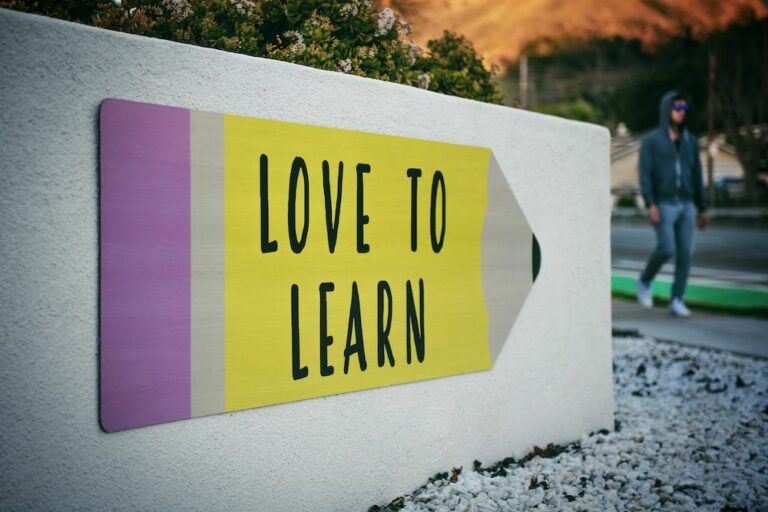
Vygotsky’s Theories and How to Incorporate Vygotsky’s Theories in The Classroom
Lev Vygotsky was a Soviet psychologist, sociologist and educationalist. His ideas and theories have been influential…

Piaget’s Preoperational Stage of Cognitive Development
In Piaget’s framework for cognitive development, the shift from the sensorimotor stage to the preoperational stage…

Jean Piaget: Biography, Theory and Cognitive Development
Over the course of his remarkable career of nearly 75 years, Piaget opened the doors to…

Concrete Operational Stage of Cognitive Development
Piaget proposed a sequence of developmental stages that children go through as they mature and acquire…
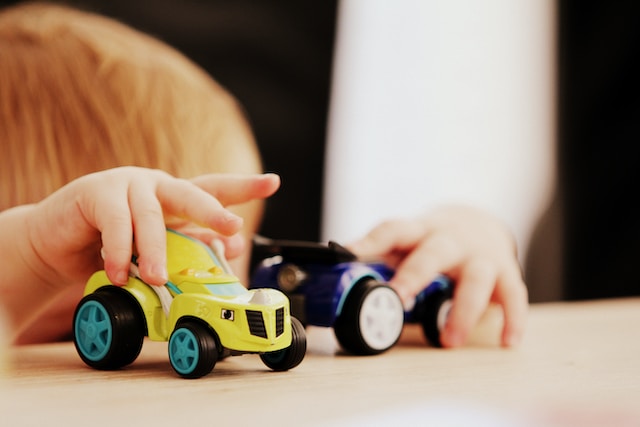
In the field of developmental psychology, the everyday family scene of a child using a spoon…

Formal Operational Stage: How Parents Support Cognitive Development
By: Author Dr. Patrick Capriola
Posted on Published: August 8, 2019

A young girl sits on a kitchen counter, attempting to write a science essay titled “What would the world be like if the scientific method wasn’t developed?” After scribbling a few ideas, Fiona gets visibly annoyed and scrunches up another page to throw towards the bin.
Fiona is another teenager who’s been struggling with school work and her father watches unhappily from the stove as his daughter worries. He may not understand it yet but Fiona is struggling with the formal operational stage.
What is the formal operational stage? The formal operational stage is the final stage of Jean Piaget’s theory of cognitive development. During this time, children start thinking about abstract concepts and hypotheticals. The formal operational stage starts around the age of 11 and continues through to adulthood.
This type of deductive reasoning is needed in STEM subjects and a technologically driven society.
In a difficult world, every parent wants their child to succeed. However, not all parents know how to help their child through tough developmental stages as they grow and take on the world.
There is some quality research out there that should help parents to understand and guide their kids through what Piaget called the Formal Operational stage.
While many early child psychologists focused on children’s physical and emotional growth, Piaget’s theory was meant to look at how humans acquire knowledge through exploration.
His theory broke down development into four stages, beginning with simple actions like grabbing objects as a baby during the sensorimotor stage, playing make-believe with household objects in the pre-operational stage and understanding that the amount of milk in a cup can be the same as the amount of milk in a jug although it appears to be less, during the concrete operational stage.
Most children eventually finish the development with the formal operational stage.
During this time they are them thinking about hypotheticals such as where they would place a third eye on their body and explaining their choices.
This kind of hypothetical reasoning allows them to function better in the world, understanding the consequences of their actions and being able to problem-solve.
Once a child reaches this stage, their method of acquiring knowledge does not change, it only involves building upon knowledge.
Every child is different and may move from one stage to the next on a slightly different timeline. Fiona is one of those kids on her own timeline.
There’s a lot to understand about the formal operational stage.
It helps to know when your child may reach it and what parents can do to help their kids understand abstract and hypothetical concepts a little better.
Do All Children Reach the Formal Operational Stage?

No. According to Piaget, formal education and developmental stages are closely linked together and non-literate children are found to struggle significantly with deductive reasoning.
Fiona is lucky. She goes to a great school and has a strong support system at home, so she’ll reach the formal operational stage soon enough.
Even if she wasn’t in a great school, her parents shouldn’t worry too much, because they are her primary teachers and have the power to ensure she is exposed to experiences that will aid in her development.
At home, they can challenge her by giving her roles that increase in responsibility and complexity.
If they assist her along the way, they can fuel her ability to think critically and solve problems.
Formal Operational Stage Examples
During the formal operational stage, children should be able to show deductive reasoning when presented with “what if” situations.
What if the snow was warm? What would you do with a million dollars? What if no one had hair anymore?
The ability to grasp examples that have no basis in the child’s reality demonstrates more common instances of having achieved the formal operational stage.
Fiona’s essay is a perfect example of a hypothetical “what if” and her frustration shows that she hasn’t quite gotten the hang of the type of thinking acquired during the formal operational stage.
Piaget explored this abstract thinking by asking children where they would place a third eye if they had one.
Younger children generally answered that they would place the third on their forehead, as that is their concrete understanding of where an eye should be.
Older children were able to give ideas like placing the eye on the back of the head as that would help with seeing what’s happening behind them. ( source )
One of Piaget’s experiments to assess formal operational thought was through the use of scale and weights.
Children were given the task of creating balance by hooking different-sized weights to a scale.
While a child in the concrete operational phase would work through trial and error, placing and moving weights multiple times to achieve balance, a child in the formal operational stage would understand that heavier weights closer to the center of the scale would balance lighter weights placed farther from the center.
This reminds us that the formal operational phase is closely linked to mathematical and scientific concepts.
Maybe this is why Fiona’s grades aren’t great in mathematics and science.
While the bulk of her classmates can calculate answers in their heads and answer the teacher confidently, Fiona has to write equations down before she can get to the correct answer.
Within the classroom setting, students who have reached the formal operational stage are able to better understand and solve problems presented on paper.
Because they can understand concepts hypothetically, they do not need props or objects to prove a hypothesis but instead can work through their own mental representations.
This allows them to understand and continue patterns, break down situations and come to logical conclusions based on existing knowledge.
How Parents Can Tell if their Child has Reached the Formal Operational Stage

All children reach Piaget’s third concrete operational stage, barring any kind of learning disability.
Fiona did. So how are Fiona’s parents supposed to tell when their child has started moving beyond this stage into the formal operational?
During the concrete operational stage, children between the ages of 7 to 11 start applying principles and logic to their thinking.
They can solve problems in a rational manner but it generally involves objects or events within their frame of reference.
They understand the concept of conservation that allows them to reason that an object can change its volume, size or appearance and still remain the same object.
Fiona had always been a creative kid and she understood the many ways that she could play with clay.
Whether she was making animals or cars out of the clay, she always had enough.
She also helped her little brother when he wanted to make a lion out of her clay, as children in the concrete operational stage become less egocentric and care more for the needs of the people around them.
The formal operational stage calibrates a child’s understanding of the world and their own theories about it.
During this stage, the child should be able to hypothesize and handle abstract thoughts in their minds.
If they are still writing or drawing to reach conclusions, then they are still in the process of transitioning to the formal operations stage.
Fiona finally loses her cool with her essay, scratching at her next page in frustration. Her dad is at his wit’s end and can only pat her back sympathetically. This is when he needs some informed help.
How Parents Can Help Their Child During the Formal Operational Stage

Parents can help their child by breaking down concepts step-by-step, allowing their child to draw on their own knowledge while giving them the confidence to explore for themselves.
Visual aids like pictures and videos are great resources for children to build their knowledge. Let’s see what happens between Fiona and her father.
Fiona looks up at her father in frustration and says “Dad, I can’t get this. Where do I even start?”
Her dad grabs his laptop off the counter and sits down next to her. “Let’s start this way.
What do you know about the scientific method?” He googles a few pictures of scientists carrying out the process as Fiona speaks.
Fiona started explaining its structure, remembering quite a lot from the class and the movie they had seen about the scientific method.
Her dad told her to write down the main driver behind its development and the impact it made.
Fiona smiled down at her list, “I actually remember quite a lot. Cool.”
“That’s great, hon.” Her dad encouraged her, “Now thinking about those effects, how would the world have been different if the scientific method was never developed?”
“Well, maybe the world would not have benefitted from all of this scientific and technological innovation?”, she said.
“Well done, that’s a great start!”, he said.
Fiona grinned up at her dad, “I think I’m getting it now.”
“Yeah, you are. Now, how do you think the people who believed in geocentrism felt at the time the method was being developed?”, her father asked.
Fiona rattled off another possible scenario, thinking about what she had learned about the geocentrism and what people were traditionally taught back then.
Her father is demonstrating how parents can help their child develop through the formal operational stage by encouraging them to view things from different perspectives, even when they disagree with them or the other viewpoint is found to be wrong.
This includes examining cross-cultural contexts that expose the child to frames of reference that they may not have encountered in their own lives.
Her dad smiled as he got back to the stove. Phew, another parenting moment that he had gotten right.
He was glad that Fiona went to a school which taught through a variety of media and texts, as rigorous education is a vital factor in promoting strong cognitive development.
Children should be encouraged to learn through their own desire for knowledge and understanding of the world around them.
Fiona’s dad knew that he couldn’t give her any answers but he needed to help her think along the right lines to come up with an answer on her own. ( source )
In time, Fiona was on a roll and happily wrote new ideas down about this hypothetical world, which honestly didn’t sound that great.
She seemed to like what she was doing. Her dad wondered if he should bring more social components into her writing.
“Do you think that the scientific method can solve all problems?”
Fiona bit the end of her pencil as she thought. Children should be encouraged to think about broader concepts in their world, which assists in their cognitive development.
Parents should be there to guide them, especially through complex scenarios as children explore information from a variety of sources.
Since Fiona had happily completed her homework, she chatted to her father for a while longer.
Her father asked her what gift they should get for her mother’s upcoming birthday.
Fiona thought about what her mother liked and disliked and how she might possibly react to certain gifts as her dad offered some options.
Parents can also include children in important decision-making at home, encouraging them to think through the consequences of those choices before making a decision ( s ource ).
Fiona’s dad also knows now that her little brother may need some help reaching the formal operational stage since he is 9 years old, he wondered if there were any toys or activities that could help with the process.
What Toys or Activities Can Be Used for Formal Operational Stage Play?
This pattern game challenges players to reconstruct the pattern in front of them using the pieces they are provided.
For each round players try to recreate the same model, whoever completes it fastest wins and it’s on to the next round.
This is an easy one for kids to take a liking to.
Check it out on Amazon here .
This puzzle building game allows the player to build in either 2D or 3D.
Puzzles vary in difficulty, allowing the player the opportunity to get used to it and improve quickly.
Over time, kids can improve their critical thinking and visual spatialization skills without even realizing they are working.
Buy it on Amazon here .
Monopoly teaches the basics of money management, encouraging children to think about the right moments to spend and save, depending on their own budget and the purchases of the players around them.
It also encourages children to think about other perspectives as they calculate what other players may be trying to do on the board.
See it on Amazon here .
Rubik’s Cube
Rubik’s Cube involves the use of logical thinking. Every movement of a color creates a consequence somewhere else on the cube.
This encourages children to think holistically and hypothesize movements and solutions before actually committing to action.
Buy it here on Amazon .
Team Sports
Team sports encourage participation and social interaction. As children are moving away from an egocentric viewpoint, team sports encourage compromise and understanding of other perspectives.
They also create opportunities for children to interact with peers from other cultural backgrounds, sharing differing frames of reference.
One Toy that Shouldn’t Be Used for Formal Operation Stage Play
Tablets are tempting for parents because they present what appears to be a modern method of learning.
The research does not support this unless the child is working on something highly effective like Lego We Do 2.0.
If you want to learn more about using Lego We Do 2.0 with your child, read this article .
Children who spend significant time in front of screens may struggle with focus and face a reduced ability to be creative and think critically about the world around them.
Too much screen time also promotes isolation, as they do not encourage children to interact with each other in a natural manner.
As with all objects, everything should be used in moderation.
While toys are a helpful way of encouraging deductive reasoning and problem-solving skills, they cannot be used as the only or best means of achieving these skills.
Piaget’s theory is based on the concept of exploration and children should be encouraged to explore the world in a way that is both safe and comfortable for them.
Why the Stages of Cognitive Development are Important for Parents.
The stages of cognitive development give parents a framework to help their children progress healthily into adulthood.
It also helps manage the expectations of parents in a competitive world, encouraging parents not to push their children to do too much before they are cognitively ready for the next stage.
Fiona and her brother will get to the formal operational stage with positive reinforcement and assistance, but the purpose is to encourage independent thinking and the search for knowledge in children in a natural way ( source ).
Does a child have to reach the formal operational stage to be successful in school?
No. The theory only looks at the concept of knowledge acquisition and not at emotional or social issues that have a substantial effect on student success.
The formal operational stage has no bearing on behavior, motivation or work-ethic which are keys to success in formal education.
If Fiona had given up and her father had not been around, she possibly would not have continued with her essay at all, beginning a pattern of demotivation around difficult schoolwork. ( source )
Is Piaget’s theory a perfect framework for cognitive development?
No. Some criticisms of the theory include accusations of Piaget creating over-complicated scenarios for children.
Some studies have found that children can demonstrate skills and knowledge through simpler scenarios and Piaget may have underestimated their abilities.
Piaget did not always account for cultural differences as well, as some of his experiments were not appropriately phrased and made assumptions about some non-literate cultures as not having reached the formal operational stage when they actually had.
It is a framework that is still taught today, and many people make reference to it. Some of its ideas are helpful to provide a frame of reference, but it should not be considered completely reliable.
The Edvocate
- Lynch Educational Consulting
- Dr. Lynch’s Personal Website
- Write For Us
- The Tech Edvocate Product Guide
- The Edvocate Podcast
- Terms and Conditions
- Privacy Policy
- Assistive Technology
- Best PreK-12 Schools in America
- Child Development
- Classroom Management
- Early Childhood
- EdTech & Innovation
- Education Leadership
- First Year Teachers
- Gifted and Talented Education
- Special Education
- Parental Involvement
- Policy & Reform
- Best Colleges and Universities
- Best College and University Programs
- HBCU’s
- Higher Education EdTech
- Higher Education
- International Education
- The Awards Process
- Finalists and Winners of The 2023 Tech Edvocate Awards
- Award Seals
- GPA Calculator for College
- GPA Calculator for High School
- Cumulative GPA Calculator
- Grade Calculator
- Weighted Grade Calculator
- Final Grade Calculator
- The Tech Edvocate
- AI Powered Personal Tutor
Teaching Students About Xavier: Renegade Angel – An Exploration into Surreal Animation
Teaching students about flashdance cast: a creative approach to film history, teaching students about hellenistic culture and its impact, teaching students about stokely carmichael: civil rights, black power, and the legacy of a revolutionary, teaching students about blackadder: a timeless educational tool, teaching students about james mccartney: a comprehensive guide, teaching students about scott parker: inspiring the classroom through the life of a resilient sportsman, teaching students about foster brooks, teaching students about necaxa: a unique learning experience, teaching students about “the crow cast”: an insightful approach to art education, piaget’s theory of cognitive development: the formal operational stage.

In his theory of cognitive development , Jean Piaget stated that there are four stages that each individual goes through . The fourth and last stage of cognitive development is called the Formal Operational Stage. This period takes place at around 12 years old and lasts well into adulthood.
What Happens During the Formal Operational Stage?
This is the time when thinking skills become advanced and more sophisticated. Those in this stage can think about abstract and theoretical concepts and can use logic to come up with solutions to problems.
Skills such as logical thought, deductive reasoning, and systematic planning are developed during this time.
Developing the Idea: Piaget’s Research
Jean Piaget conducted tests to support his theory of cognitive development. For the Formal Operational Stage, he came up with two: (1) physical conceptualization and (2) abstraction of thought.
For physical conceptualization, he used the concept of balance. Children from different age groups were asked to balance a scale. He found that those in the Formal Operational Stage (approximately 13 years old) made a hypothesis about where to place the weights to achieve balance. 10-year-old subjects used the trial-and-error method, while 7-year-olds placed weights on each side of the scale but did not consider the placement of the weights. Subjects younger than 7 years old were not able to complete the task because they did not understand the concept of balance.
In the second test, which had to do with the abstraction of thought, children were asked to think of where to put a third eye if they could have one. Most of the younger children stated that they wanted to place the third eye in the middle of the forehead, while those in the Formal Operational Stage suggested more creative answers like putting it behind the head to see what’s happening behind them.
Creative ideas such as the answers provided by the children in the Formal Operational Stage are indicative of the use of abstract and hypothetical thought.
Notable Skills
The skills listed below are indicators of the Formal Operational Stage of Cognitive Development:
1. Deductive Logic – this has to do with being able to think in broader terms. Children at this stage can come up with solutions to problems using logic and general principles. This skill is useful in Science and Math.
2. Abstract Thought – has to do with being able to think about abstract ideas. They consider possible outcomes, which include out-of-the-box ideas to solve problems. This skill is useful for long term planning.
3. Problem Solving – is the ability to plan an efficient and logical approach to solve a problem.
4. Hypothetical-Deductive Reasoning – children at this age think about what-ifs and attempt to formulate various solutions to solve them.
The Formal Operational Stage is the last of four stages of cognitive development posited by Jean Piaget. Formal operational thinkers can think of different solutions to solve a problem, including those that are creative and abstract. Individuals in this stage think carefully before they act.
How to Implement the Create a Headline ...
The edvocate’s guide to solitary play.
Matthew Lynch
Related articles more from author.
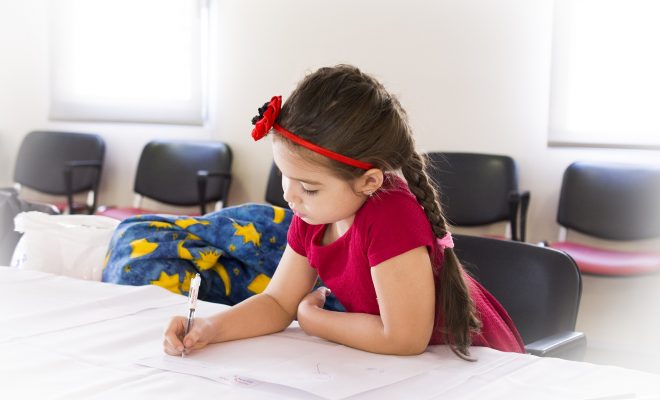
Top 3 Benefits of Learning Through Play

18 SEEK AND FIND BOOKS FOR KIDS

24 Ways to Teach Kids to Control Their Temper
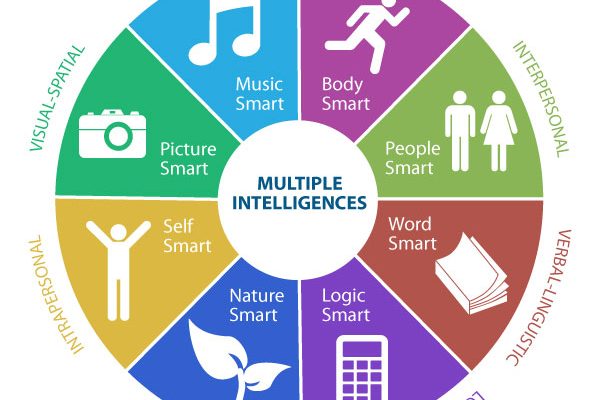
Intelligence in America: Time to Test Something New

20 Picture Books to Welcome Spring

Emotional Intelligence Apps, Tools, and Resources That We Love
Have an account?

Piaget's stages of cognitive development
10th - 12th grade, social studies.
15 questions

Introducing new Paper mode
No student devices needed. Know more
- 1. Multiple Choice Edit 1 minute 1 pt How many stages are in Piaget's theory? 5 9 4 2
- 2. Multiple Choice Edit 45 seconds 1 pt The process of taking in new information and adding it to what the child already knows is called __________ accommodation schemata assimilation all of the above
Problem solving and ______ are developed during the fourth stage, formal operational.
questioning
- 4. Multiple Choice Edit 30 seconds 1 pt Piaget's theory of development focuses on predictable _____ stages. consecutive cognitive followed none of the above
__ are mental representations or concepts.
- 6. Multiple Choice Edit 30 seconds 1 pt The first stage of development is the _____ stage. adaptation assimilation accommodation sensorimotor
- 7. Multiple Choice Edit 30 seconds 1 pt During the preoperational stage children a very _________ independent loud egocentric self centered
- 8. Multiple Choice Edit 45 seconds 1 pt ____ is adjusting what is already known to fit the new information. schemata assimilation accommodation Really?
According to Piaget a child acts like this sort of scientist
associative
- 10. Multiple Choice Edit 45 seconds 1 pt Cindy understands her world primarily by grasping and sucking easily available objects. Cindy is clearly in Piaget's ________ stage preoperational concrete operational sensorimotor formal operational
- 12. Multiple Choice Edit 20 seconds 1 pt The inability of young children to see the world through someone else's view is termed: Centration Irreversibility Conservation Egocentrism
- 13. Multiple Choice Edit 20 seconds 1 pt Peek-a-boo works on children in what stage? Sensorimotor Preoperational Concrete Operational Formal Operational
- 14. Multiple Choice Edit 20 seconds 1 pt The ability to use deductive logic, think abstractly and systematically solve problems emerges during the: Concrete Operational Stage Sensorimotor Stage Formal Operational Stage Preoperational State
- 15. Multiple Choice Edit 20 seconds 1 pt In which of the following stages will children learn the concept of conservation? preoperational concrete operational sensorimotor formal operational
Explore all questions with a free account

Continue with email
Continue with phone

IMAGES
VIDEO
COMMENTS
The Formal Operational Stage is the final stage in Jean Piaget's Theory of Cognitive Development, where children develop many skills. ... there are ways that you can heighten your abstract problem-solving skills from age 12 to age 112! ... Freud's Stages of Psychosexual Development. During the ages of 11-12, a child is in the latent stage of ...
The formal operational stage is the fourth and final stage of Jean Piaget's theory of cognitive development. It begins at approximately age 12 and lasts into adulthood. In the formal operational stage, children's thinking becomes much more sophisticated and advanced. Kids can think about abstract and theoretical concepts and use logic to come ...
The formal operational stage begins at approximately age twelve and lasts into adulthood. As adolescents enter this stage, they can think abstractly by manipulating ideas in their head, without any dependence on concrete manipulation (Inhelder & Piaget, 1958). In the formal operational stage, children tend to reason more abstractly ...
Piaget divided children's cognitive development into four stages; each of the stages represents a new way of thinking and understanding the world. He called them (1) sensorimotor intelligence, (2) preoperational thinking, (3) concrete operational thinking, and (4) formal operational thinking. Each stage is correlated with an age period of ...
preoperational. concrete operational. formal operational. The goals of each stage are understanding: object permanence. symbolic thought. operational thought. grasping abstract concepts. Piaget ...
It has four distinct stages: sensorimotor, preoperational, concrete operational, and formal operational. Each stage has different milestones and skills. Jean Piaget was a renowned psychologist and ...
3. The Concrete Operational Stage. The next phase is the concrete operational stage, which begins around the age of seven. During this stage, children are more capable of solving problems because they can consider numerous outcomes and perspectives. All of their cognitive abilities are better developed in this stage.
This stage of cognitive development, which Piaget called formal operational thought, marks a movement from an ability to think and reason from concrete visible events to an ability to think hypothetically and entertain what-if possibilities about the world. An individual can solve problems through abstract concepts and utilize hypothetical and ...
Piaget proposed four stages to describe the development process of children: ... which is the best path to follow in solving the problem. During this stage the adolescent is able to understand love, logical proofs and values. ... Abstract thought emerges during the formal operational stage. Children tend to think very concretely and ...
Figure 10.4.1 10.4. 1: Teenage thinking is characterized by the ability to reason logically and solve hypothetical problems such as how to design, plan, and build a structure. [1] Figure 10.4.2 10.4. 2: Piaget proposed that formal operational thinking - hypothesis creation, testing and deduction - is the last stage in cognitive development. [2]
Transcript. Piaget's cognitive development theory outlines four stages: sensorimotor, preoperational, concrete operational, and formal operational. Each stage, occurring at different ages, represents unique ways children understand and interact with the world. Key concepts include object permanence, symbolic thinking, conservation, and abstract ...
formal operational stage, stage of human cognitive development, typically beginning around age 11 or 12, characterized by the emergence of logical thinking processes, particularly the ability to understand theories and abstract ideas and predict possible outcomes of hypothetical problems. The formal operational stage is the fourth and final stage of Swiss psychologist Jean Piaget's theory of ...
The late Swiss psychologist Jean Piaget was a major figure in the study of cognitive development theory in children. He believed that it occurs in four stages—sensorimotor, preoperational, concrete operational, and formal operational. This article discusses Piaget's stages of cognitive development, including important concepts and principles.
Problem Solving - is the ability to plan an efficient and logical approach to solve a problem. 4. Hypothetical-Deductive Reasoning - children at this age think about what-ifs and attempt to formulate various solutions to solve them. Summary. The Formal Operational Stage is the last of four stages of cognitive development posited by Jean Piaget.
During the formal operational stage, adolescents are able to understand abstract principles which have no physical reference. They can now contemplate such abstract constructs as beauty, love, freedom, and morality. The adolescent is no longer limited by what can be directly seen or heard. Additionally, while younger children solve problems ...
Jean Piaget's theory of cognitive development suggests that children move through four different stages of learning. His theory focuses not only on understanding how children acquire knowledge, but also on understanding the nature of intelligence. Piaget's stages are: Sensorimotor stage: Birth to 2 years. Preoperational stage: Ages 2 to 7.
the four different stages of the cognitive development theory, namely sensorimotor, pre-operational, concrete operational and formal operational. An outline of each of the four stages is given, with a more detailed focus on the formal operational stage which we support by a specific example—the motion of a golf ball—that reflects
Problem solving and _____ are developed during the fourth stage, formal operations. a. thinking b. listening c. reasoning d. questioning. Click the card to flip 👆 ... At what age is the formal operational stage of development? a. 0-2 b. 2-7 c. 7-11 d. 12 and up. c.
After securely connecting it, her systematic and logical problem-solving in the formal operational stage has enabled her to get the computer running and complete the project on time (2). Inductive and Deductive Reasoning. In earlier development stages, children have generally learned to employ deductive reasoning.
The formal operational stage is the final stage of Jean Piaget's theory of cognitive development. During this time, children start thinking about abstract concepts and hypotheticals. The formal operational stage starts around the age of 11 and continues through to adulthood. This type of deductive reasoning is needed in STEM subjects and a ...
The parallel between the rational powers and the problem-solving processes utilized by formal thinkers is clear. One must not be misled to interpret Piaget's theory as implying that maturation of the nervous system is sufficient for the development of formal thought. If this were the case, the job of our educational system would be small indeed.
Problem Solving - is the ability to plan an efficient and logical approach to solve a problem. 4. Hypothetical-Deductive Reasoning - children at this age think about what-ifs and attempt to formulate various solutions to solve them. Summary. The Formal Operational Stage is the last of four stages of cognitive development posited by Jean Piaget.
Multiple Choice. 3. Multiple Choice. Problem solving and ______ are developed during the fourth stage, formal operational. 4. Multiple Choice. Piaget's theory of development focuses on predictable _____ stages. 5. Multiple Choice.